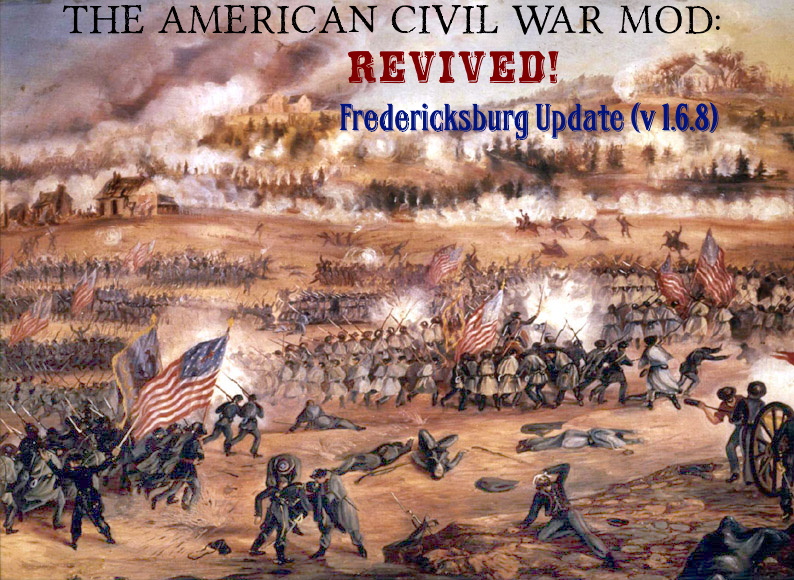
"Poor Fredericksburg! The enemy on the Stafford side of the river in force; their cannon planted on the hills. Day before yesterday they demanded the surrender of the town, which was declined by General Lee... The bombardment has not commenced, but General Lee requested last night that the women and children who had not gone should go without delay. This seems to portend hot work." ~ Diary of Judith P. McGuire. November, 1862.
- Make sure you delete any previous versions of the mod.
- Download the winrar package called, "The American Civil War Mod Revived v1.6.8", and save it to your desktop or another preferred destination that you can easily access.
- Open the package and extract the folder inside called, "The American Civil War Mod Revived", to your modules folder (C:\Program Files (x86)\Steam\steamapps\common\MountBlade Warband\Modules).
- Start Mount & Blade: Warband, select the mod from the drop down menu, and play!
You can join the mod's discord server here: Discord.gg
Since the last release, we have made some very exciting progress, and this update makes some much needed improvements on a few things that really needed addressing.
In the previous article, when I discussed how it was difficult to find accurate depictions of the Fredericksburg battlefield, Matsuri5 actually found a blog (here) which had schematics of the town of Fredericksburg from 1856, and this included the area of the battlefield. These schematics, which I will show below, provided a detailed look at how the roads were laid out exactly as they were at the time of the battle.
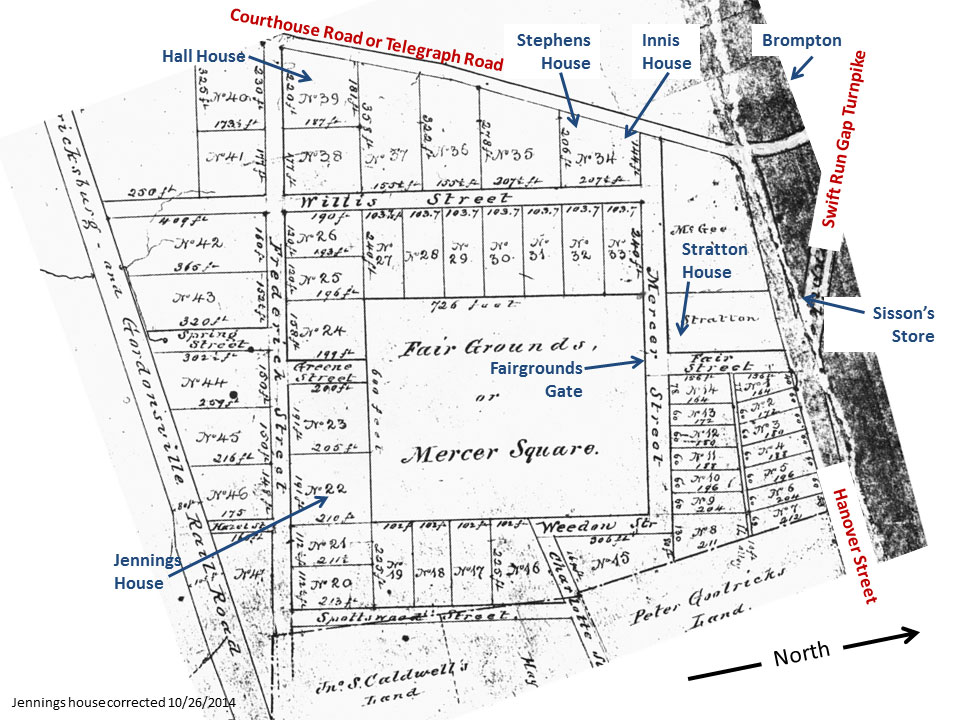
This made me realize that there was much that was missing from the original design of the Fredericksburg scene in the mod, and this new information, along with much more that was available on the Mercer Square blog allowed me to make a more accurate depiction of the battlefield.
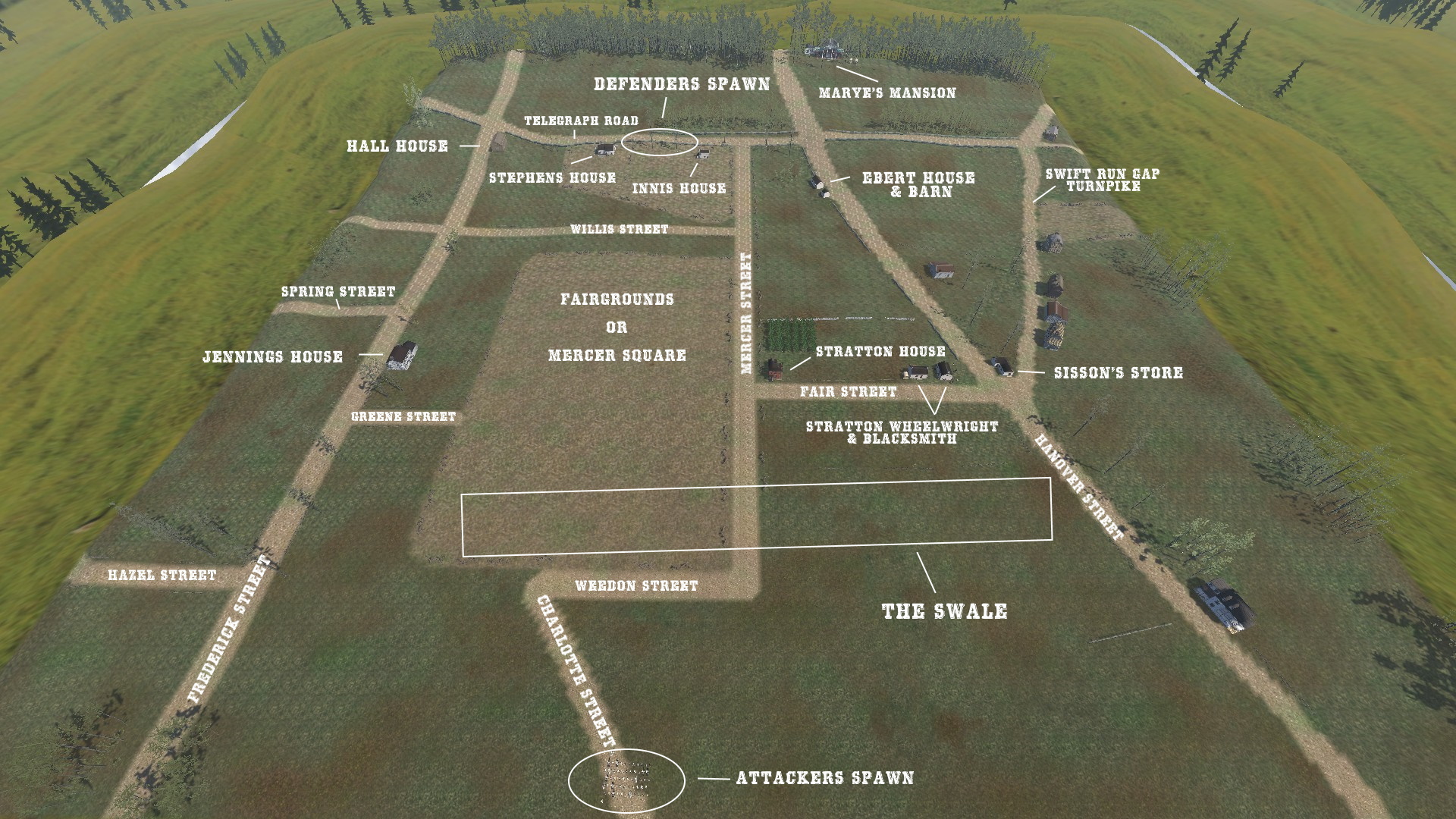
The blog also had a lot of details about the buildings that were present on the battlefield, including their exact locations and what they looked like. Matsuri5 has made a beautiful set of replicas of the most prominent buildings on the battlefield, including Marye's Mansion, the Innis House, the Stephens House, the Ebert House and Barn, the Stratton House, the Stratton Wheelwright and Blacksmith, and the Sisson's Store. The Jennings House and the Hall House shown on the above overview are not replicas, however, due to the lack of any records of what those houses looked like. The buildings are still authentic homes from the time period. I'll show some photos of these buildings in game, and I will also give some information about the history of the buildings as well.
Marye's Mansion
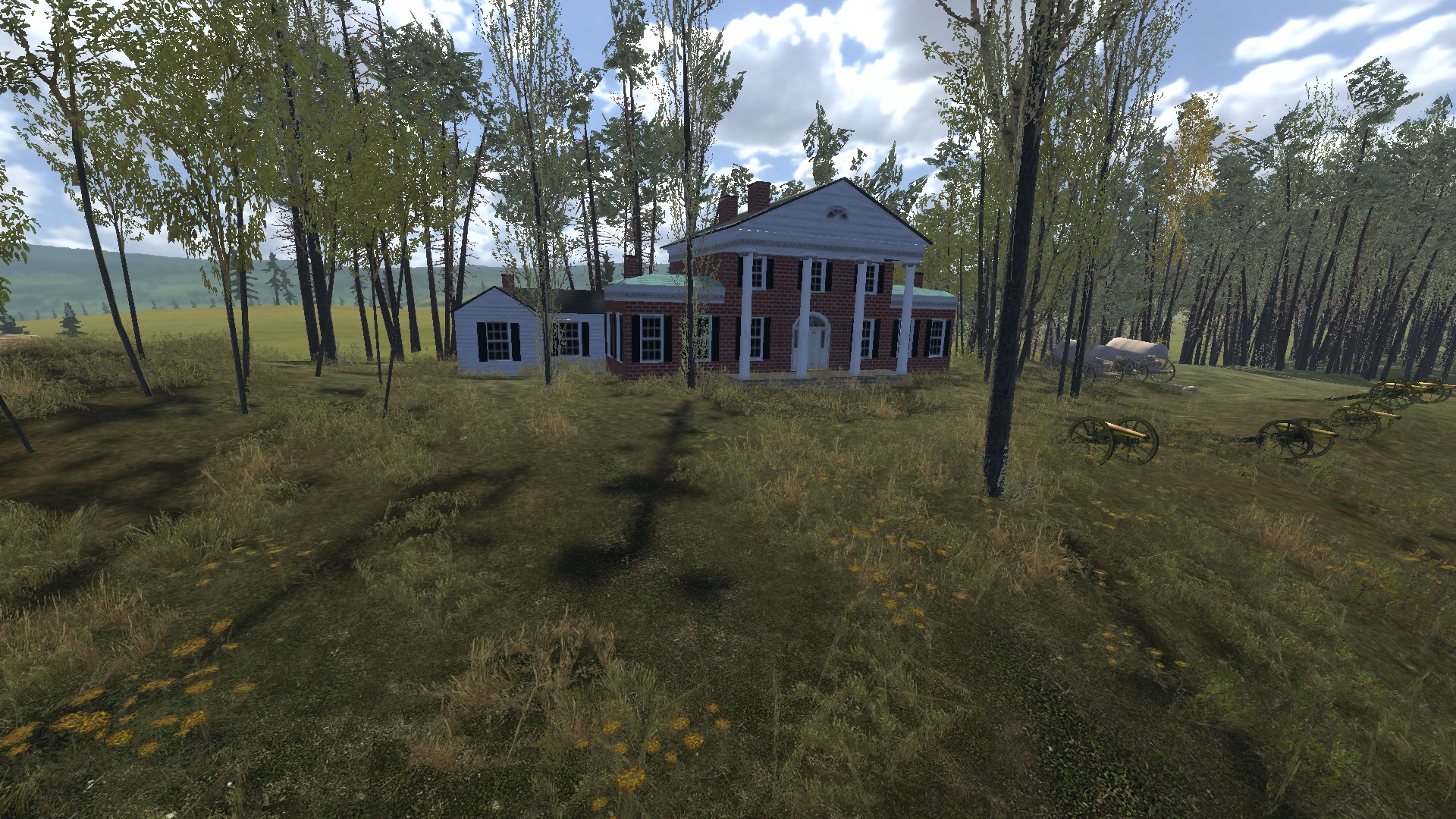
The Marye house, now known as Brompton, stands where long ago one of the homes of the Willis's stood, the family whom Willis Hill is named for. It is a handsome, imposing brick structure with a white columned porch that overlooks the city of Fredericksburg and the plain nearer the Heights, across which thousands of Union soldiers charged to their death during the Civil War. The house was built by John Lawrence Marye Jr. in 1838, a Virginia lawyer, plantation owner, and politician. Originally, it was a rectangular structure, but Marye added wings and a porch to the building, giving it a graceful appearance that it still enjoys today.
The Maryes were prominent in Virginia in the days before and during the war; John L. Marye Jr. served as Fredericksburg's mayor from February 12th, 1853 until March 21st, 1854. He operated a farm in Spotsylvania County near St. Georges, and he or his father owned 10 enslaved people in 1850, and at least two slaves in 1860. Spotsylvania County voters elected J.L. Marye Jr. as one of their delegates to the Virginia Secession Convention in 1861. A conditional Unionist, he at first voted against secession, hoping that the North and South would settle their differences amicably. But then, after the militia call up by Abraham Lincoln to restore Federal property in the South, Marye reluctantly joined a majority of other delegates in voting the state out of the Union. He little imagined the impact that decision would have on his family and house.
For the first 18 months of the war, Fredericksburg suffered little from the fighting. Marye volunteered for the Confederate army shortly after Virginia's secession, serving as a private in Pollock's Company (also known as the Fredericksburg Light Artillery). Despite his relatively advanced age, J.L. Marye Jr. rose to the rank of sergeant before his discharge. In November 1862, the opposing Union and Confederate armies converged on the town for the Battle of Fredericksburg. General Robert E. Lee, commanding the Confederate forces, occupied a seven mile defensive line that stretched across the heights south and west of the town. Part of Lee's line ran along Marye's Heights, past J.L. Marye Jr.'s front door. The house served as Confederate General James Longstreet's headquarters during the battle of Fredericksburg, and was the center of the Confederate line. Colonel James Walton commanded an artillery battalion in Lee's army, and nine of his guns crowned the heights. Below them, in a sunken section of Telegraph Road, stood a brigade of Georgia riflemen led by Thomas R.R. Cobb. On December 13th, 1862, Union troops poured out of the town and attacked Marye's Heights. Cobb's men easily repelled the assault, aided by Walton's guns on the ridge and by sharpshooters firing from the upper windows of the Marye house.
Over the next eight hours, no less than 18 brigades made up of more than 30,000 men attacked Marye's Heights, prompting Lee to reinforce the position. At 2:00 P.M., he ordered four South Carolina regiments to join Cobb and Walton on the ridge. The 2nd and 8th South Carolina augmented Cobb's men in the road, and the 3rd and 7th South Carolina took position on the ridge above. Unfortunately, Colonel James D. Nance led the 3rd South Carolina to an exposed knoll in front of the Marye house, and immediately began to take casualties, and even though he ordered his men to lie down, losses continued to mount. As Colonel Nance hurried to find a more sheltered position, he was struck in the thigh by a Minié ball. Command passed to the unit's lieutenant colonel, but he too fell, with a bullet striking him in the side. The regiment's major and senior captain were incapacitated as well, and command passed to Captain John C. Summer. Summer was not a religious man, and it was, therefore, with some surprise that a fellow officer found him on his knees in prayer before the battle. When the officer jokingly suggested that fear had prompted his friend's newfound piety, Summer replied seriously that he was going to die in the coming battle and thought it wise to make his peace with God. His premonition proved accurate. Moments after taking command of the regiment, a bullet struck Summer in the head, killing him instantly, and making him the sixth commander from the 3rd South Carolina to fall in the battle. Reflecting on the regiment's exposed position in front of the Marye house, a South Carolina soldier commented that it was, "wonderful everyone was not either killed or wounded." As it was, 166 men were hit.
A Confederate staff officer who visited the structure after the battle observed that, "Not an inch of the surface of the bricks on the front of the house was free from the mark of a Minié ball. Bushels of flattened ones were to be seen on the ground, while the woodwork was torn to pieces by them". Another soldier wrote that the building had been, "raked by musket balls until it looks as if a hail storm had scoured it." A second round of Union assaults against Marye's Heights during the Chancellorsville Campaign in May 1863 only added to the damage. By battle's end, Marye's house was a battered shell of its former self. A man who visited the house in 1864 commented on the desolation, "Ah! It was a sad thing to thread the deserted halls and chambers of this old house and hear only the echo of your footsteps. Not even a rat squeaks behind the wainscot. The silence is awful." The damage extended beyond the house and onto the grounds, which were scarred by earthworks and hasty graves.
During the Wilderness and Spotsylvania operations of May 1864, the Marye House became a vast hospital overnight, as ambulance wagons rolled in bearing more than 10,000 wounded Union soldiers. IX Corps surgeons commandeered the house, packing it with hundreds of injured men. As the weather improved, many of the wounded were carried out of the stifling house and placed under a large oak tree on the east lawn, which still stands today. Nearby, soldiers dug a long trench in which to bury those who did not survive their injuries. After the war, these bodies would be moved down the ridge a few hundred yards and buried in Fredericksburg National Cemetery. John Marye returned to his house in 1865 and began repairs, but died a few years later in 1868. His heirs sold the estate to John G. Lane and Lane's family, in turn, sold the property to Captain Maurice B. Rowe, who made it into a thriving dairy farm.
As years passed, many Union and Confederate veterans stopped to see the house that had played such a large part in their lives. One Union veteran even asked to be married there, explaining to the owner, "he was unable to take Marye's Heights by storm in December of '62, [and] that he wanted to take it now in his own way by being married there."
Today, although the Marye house is not open to the public, you can get a good view of it from both the Sunken Road and from Hanover Street. On the house and outbuildings are hundreds of scars of battle, which can still be seen today, including trenches which can be found along the edge of the beautiful lawn. The house currently serves as the residence of the President of the University of Mary Washington.
The Innis House
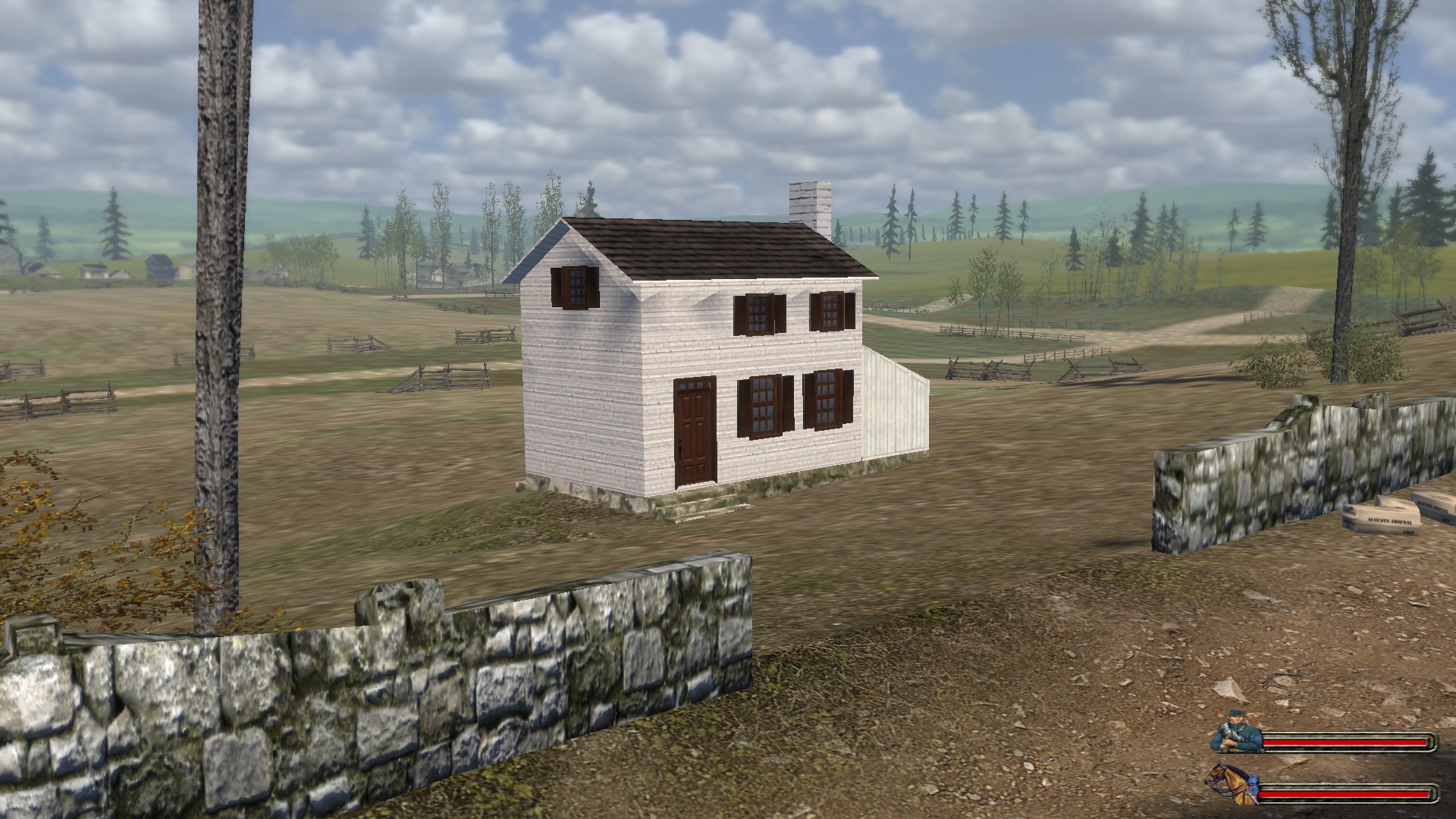
The Innis house was built sometime prior to 1850 although the actual construction date is unknown, however there is a record of a structure "below Brompton" when John Howison sold his property to a group of land investors in 1854. The house is located at the corner of Mercer Street and the Sunken Road (originally called Telegraph or Courthouse Road). It was owned by Martha who went by any of three last names: Farrow, Innis and Stephens, based upon city land tax records, court cases, U.S. Census records, Deed Book records and newspaper stories. The Innis house was one of several properties she owned. Martha could not read or write, yet owned land, a rarity for women in the mid-19th century. She did not have the advantage of family or wealth in the community, and Martha was a nonconformist, doing things "her way", which frequently caused legal issues. She spoke her mind to whomever she talked to, and she may not have even been remembered but for the fact that she owned a home located on the historic Sunken Road. She was listed in the 1850 Spotsylvania County census as a 25 year old head of household that included eight others. This odd assortment of people under a single roof included her two children, a sister, mother-in-law with male consort and three young women.
The house bore witness to the fighting during the Battle of Fredericksburg in December 1862, and members of Confederate Brigadier General Thomas R.R. Cobb's Brigade were lined up along the Sunken Road on either side of the Innis house during the battle. Occasionally some of these men used the windows or the roof of the structure to fire upon the Union troops advancing toward them across the open plain. Following the Civil War, Martha was known to have resisted repairing the battle damage to her houses. She readily talked to anyone that happened to pass by describing the battle, and was known to have received sympathy donations from various visitors to her property.
Today, the Innis house is an interesting historical exhibit and is the only remaining historic structure located along the Sunken Road on the National Park's Fredericksburg Battlefield land. Periodically, the Park Service opens the house for public viewing of the interior, generally in the summer months. The house itself sustained rifle and cannon fire damage in the battle that swirled around it, and the scars remain to this day. These were only uncovered after the National Park Service took possession of the house in 1975. They conducted a detailed restoration in order to return the structure to its 1862 appearance, and this restoration was completed in the early 1980's. When anything "modern" was stripped off, bullet and shell holes from the two battles (December 13th 1862 and May 3rd 1863) were revealed. It is impossible to know which of the two battles caused the damage, but it is likely that most occurred during the lengthy December 1862 fighting.
The Stephens House

In the 1860 Spotsylvania County census, Martha Stephens was listed with Edward N. Stephens, a cabinet maker, and two children, Agnes and Mary. This second common-law marriage lasted until the death of Edward Stephens in 1883. Martha's property started at the western boundary of the city, and her houses (Innis and Stephens) were just outside the city boundary, but most of her land was in the city. She sold liquor and groceries from her house without a license which caused problems with the law. As the Civil War descended upon the nation, Martha's son, John B. Innis, and her common-law husband, Edward N. Stephens, were mobilized in the Confederate army. Both were wounded at the Battle of Antietam. During the battles that occurred at Fredericksburg in December 1862 and May 1863 both men were apparently still away. An account written by Captain William Miller Owen of the Washington Artillery described the first battle,
"At noon, while sitting in Marye's garden, overlooking Fredericksburg, a note came from Gen. Longstreet for Gen. Cobb, but for our perusal… It read as follows: 'If Anderson, on your left, is badly pressed, he will fall back to the second line of heights. Conform to his movements.'
I went down the terraced hill and into the road, and found Gen. Cobb near a small house on the edge of the road and fields, and delivered the order. He read it carefully, and then said: ‘If they wait for me to fall back they will wait a long time.' "
The small house in Captain Owen's account was the Stephens house. A primary reason for General Cobb being at this location was the elevation of the house on the Sunken Road. The Stephens house is located on the high point along the Sunken Road, sitting at 98 feet (30 meters) above mean sea level. The upper tier of Mercer Square along Little Page Street is 78 feet (24 meters) above mean sea level. This provided the Confederate infantry of Cobb's Georgia Legion an elevation advantage of 20 feet (6 meters). General Cobb selected this as the location of his headquarters based upon having the Stephens house for a command post and that it was the highest terrain along his defensive front. If he had selected any other location along the road he could not observe his entire command. An alternative location might have been up on Marye's Heights but then he would have had a challenge communicating with his command while it was under fire or firing itself.
At some point after the Civil War, Martha reunited with her family, now home from the war, and reoccupied both the Innis and Stephens houses. Visitors noted that Martha steadfastly refused to do any alterations to her houses. The weather-board walls were literally riddled with bullet holes. One Confederate account remarked, "the [Stephens] house is perfectly riddled with balls, at least 2,000 holes in it". These seemed to acquire some notoriety with the coming of tourists, mostly from the north, visiting the battleground and the National Cemetery. There are some reports of Martha selling a few of the exterior boards as souvenirs. She also was remembered as a gregarious, pipe smoking woman who would spend time with visitors. It was during this time that Martha began talking about the December battle. Her story was along the lines of having sent her children west to Chancellorsville but remaining in the Stephens house during the battle. This tale evolved over time to the point where she nursed mortally wounded General Cobb in her own home. In reality, General Cobb was mortally wounded by an exploding artillery shell, and was immediately taken to a Confederate hospital behind the lines, where he died.
The local newspaper Free Lance-Star reported that Martha's house burned down on Friday morning April 25th, 1913 due to a cook stove fire. In December 1917, the Fredericksburg Chapter of the United Daughters of the Confederacy erected a granite marker for Martha just beside her well on the Sunken Road.
The Ebert House and Barn
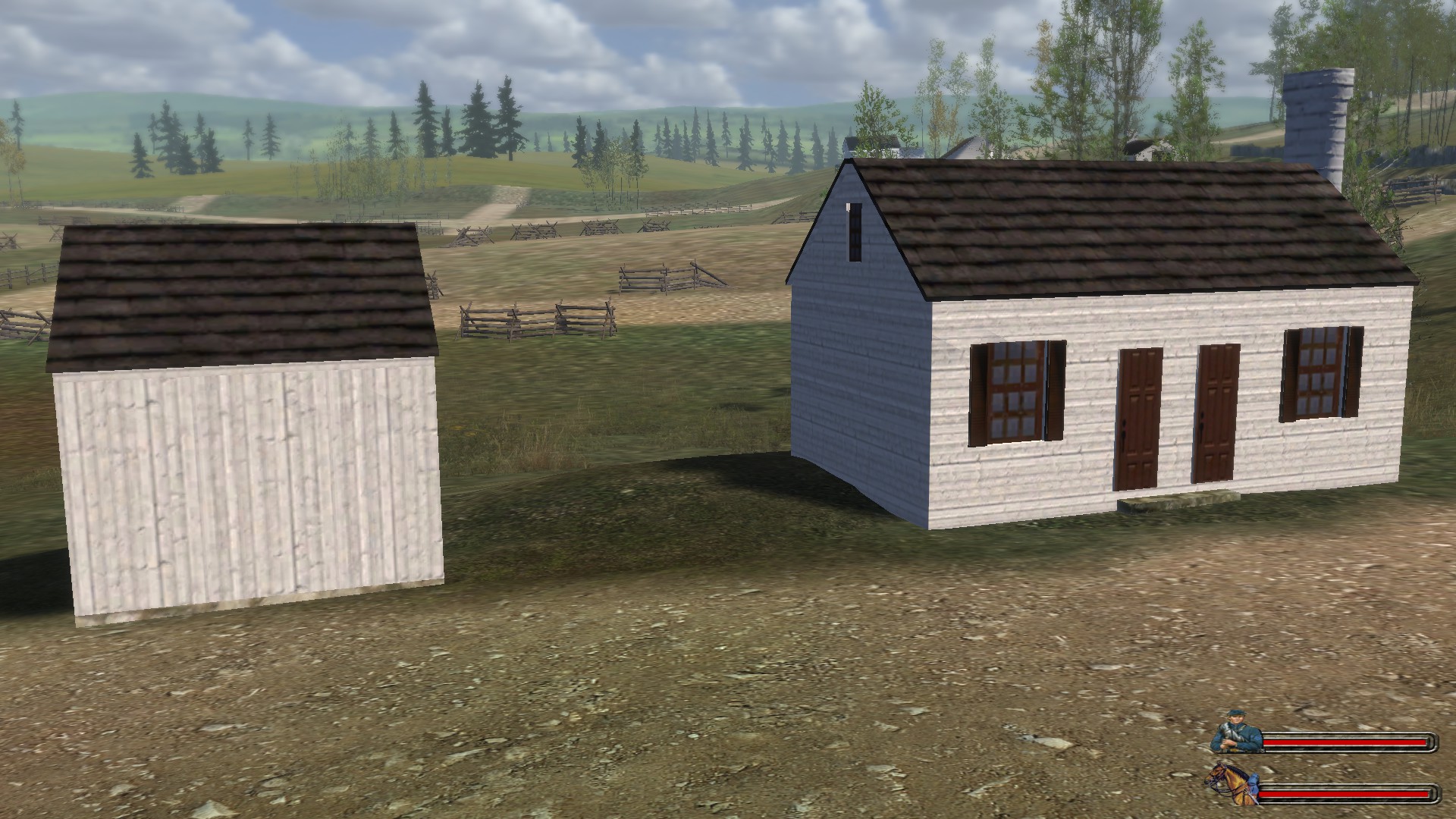
The Ebert House, or as it was sometimes known after the Battle of Fredericksburg, the "Battle House" was built possibly as early as 1826. Henry August Ebert, his wife Sophia and daughter Anna emigrated to the United States from Prussia, and according to the National Park Service sign concerning the Ebert property, the Ebert's emigration date was the 1840's. However, based upon his obituary and the date and place of birth of his eldest daughter, 1855 or 1856 is a more realistic date. In 1858, Henry purchased this property from Absalom McGee for $900. The house and small barn were located in the curve of the roadway originally known as Telegraph Road where it skirts the plain at the base of Marye's Heights. This location is now more properly identified as being at the junction of the Sunken Road and Kirkland Street. In the 1860 census, 28 year old Henry, whose last name was misspelled as "Abert", lists himself as a grocer. His wife, Sophia, also 28, is listed along with daughters Anna, age 5, Dorothy (Doretta), age 3, and Mary, age 8 months.
The Ebert house stood amidst a cluster of middle class homes just below Marye's Heights on the western edge of Fredericksburg, and all of the families who resided there were directly impacted by the war. Before the Battle of Fredericksburg, Confederate officers ordered the Ebert family (Henry being absent with the army) and the others to leave their homes. Henry's wife, Sophia, with their young daughters, took refuge with her brother's family several miles west of town. They returned days later to find dead bodies "all over the property" and their home scarred by eight hours of combat. During the battle, this end of the battlefield was assaulted by no fewer than 21 Union regiments, beginning with the 8th Ohio and culminating with Tyler's Brigade of Humphreys Division in the closing minutes of evening light. Most of these Union regiments made their way out of Fredericksburg via George and Hanover Streets. All along the way they were pounded by Confederate artillery and finally turned away by the Confederate troops posted in the Sunken Road.
Henry Ebert's war record is typical of many enlisted men in the Confederate army. He was a member of Company A "Washington Guards" of Fredericksburg, 30th Virginia Infantry, Corse's Brigade, Pickett's Division, I Corps, Army of Northern Virginia. He was listed as: Absent, sick in the November and December 1861 roll. Detailed in the March and April 1862 roll as a baker. He was hospitalized June 30th, 1864 with edema of the legs at Chimborazo Hospital in Richmond, Virginia. Hospitalized with pneumonia from January to April 1865; furloughed March 3rd, 1865. After the war, Henry returned to his family and the grocery business in Fredericksburg.
The Ebert family store remained in operation from 1858 until 1944 when the house was finally sold by the family. It was continuously owned by the Ebert family up until that time. The 1913 will of Sophia Lange Ebert, Henry's widow, bequeaths the "home and store" to her two single daughters, Mary and Doretta Ebert; the "balance of her real estate" she bequeathed to her two married daughters, Mrs. Annie L. Pfaff and Louisa Franklin. The Ebert land was sold and subsequently subdivided over time. The small rectangle of land at the west end of the property between Kirkland and Mercer Streets is today owned by the National Park Service. It is upon this land that the outline of the Ebert house foundation and the monument to Sergeant Richard Kirkland, the "Angel of Marye's Heights", stand.
The Stratton House
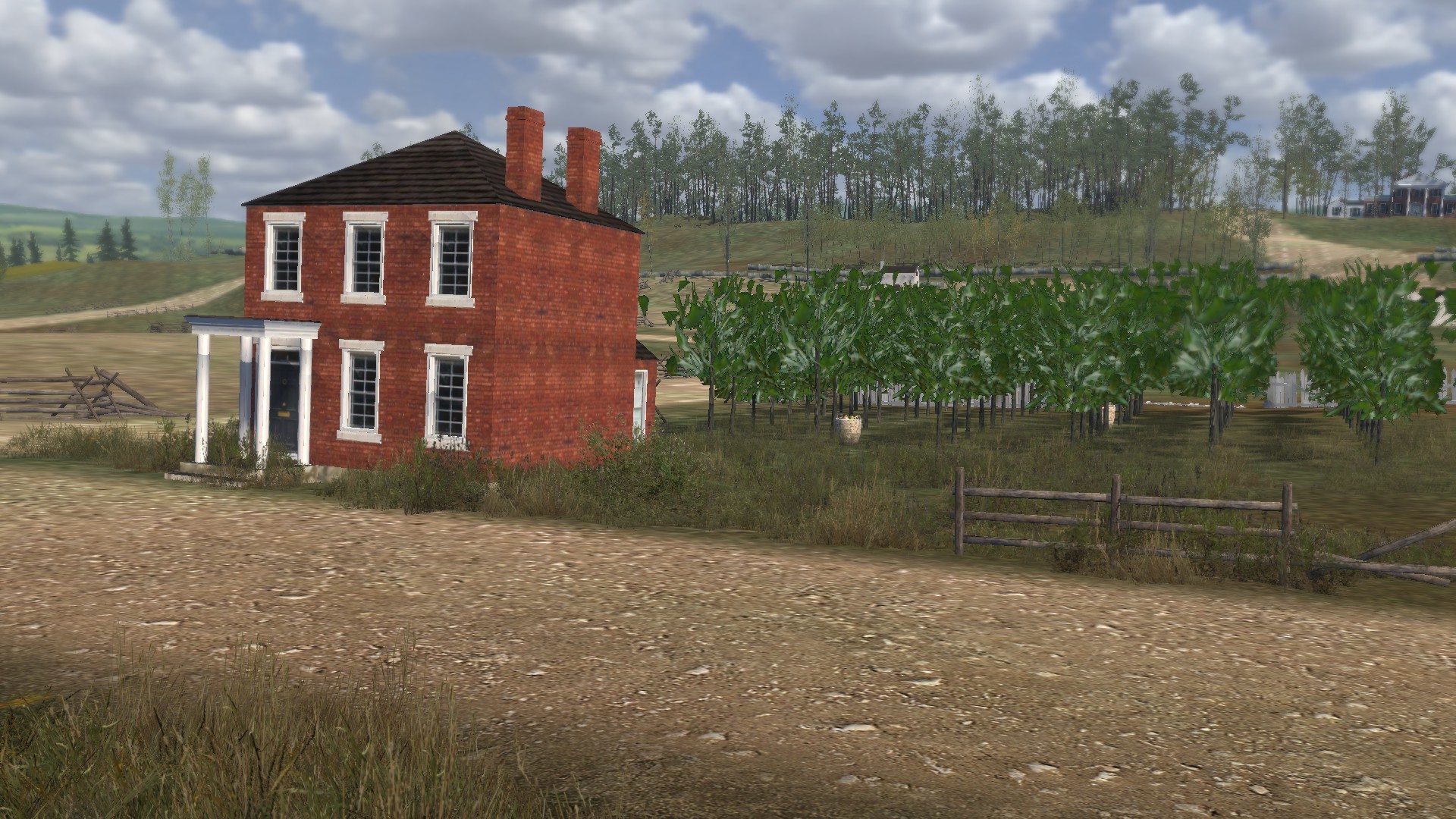
The Stratton house is one of the iconic witnesses to the Battle of Fredericksburg, and having since been much expanded, still exists today. It shows up in a number of written accounts by the participants, in drawings of the battle, and in photographs following the battle. Built by Allen Stratton, a wheelwright, in 1857 on a rectangular piece of land about one acre in size, he also constructed his wheelwright business on the same property at the opposite end, where the land abutted Telegraph Road (today's Kirkland Avenue). The property fronted Fair Street (today's Littlepage Street) between Telegraph on the north and Mercer Street on the south. This placed Stratton conveniently close to the new county fairgrounds known as Mercer Square.
The house was two stories high and built of brick, with windows front and back and a small columned porch in front. At the back of the house was a smaller one storied structure, with its own chimney, that served as a kitchen or additional living space. Directly behind the house, between the kitchen and the back fence, there was a young apple orchard, an outhouse and a pig pen enclosure. Interestingly, the orchard receives scant comment by those who fought there and is missing from photos taken two years later. The 1860 census records thirteen people as living in the house. These included John Stratton, his wife and six children between the ages of one and 17, and as well as five others between the ages of 50 and 15. If so, this was truly a crowded house, given that the original two story house was 24 feet wide and 32 feet deep, plus an attached structure to the rear. Allen Stratton married a sister of Absalom McGee, Mary McGee. Of note, one of those listed as living in the house during the 1860 census was Eliza McGee, aged 50. This was possibly an older sister, cousin or other relation. Absalom McGee was listed as the owner of the land in 1855, just before Allen Stratton acquires ownership of a portion of the land in 1855.
During the battle of Fredericksburg, the fighting around the Stratton House was intense. Many Union regiments only made it that far. Others overcame obstacles in their way and approached the deadly Sunken Road and its stone wall before they too gave way and retreated back behind the Stratton House and fence, or spilling back to the canal ditch where they formed for the assault, or all the way to the city. The movement of Union troops around obstacles, buildings and fences, was very similar to that of water in a stream or waves at the beach. The troops went around those obstacles that could not be moved over, pushed aside or knocked down. Union regiments that directly approached the Stratton House were split up with portions deviating around either side the structure. Those who went to the left side became bunched up and crowded together by the combination of the house and the fairground fence. Those troops that went to the right side of the Stratton house confronted the two fences at the front and rear of the property. The back fence was deceptively deadly. A soldier could duck down to be out of sight of the Confederates but the boards did not stop bullets. At the conclusion of the battle, there remained a windrow of Union dead and wounded strung out along the length of the fence. By the time the burial detail arrived five days later there were so many bodies laying along the fence and beyond nearer the Sunken Road that the burial detail dug a separate trench in Stratton's yard.
The Stratton Wheelwright and Blacksmith
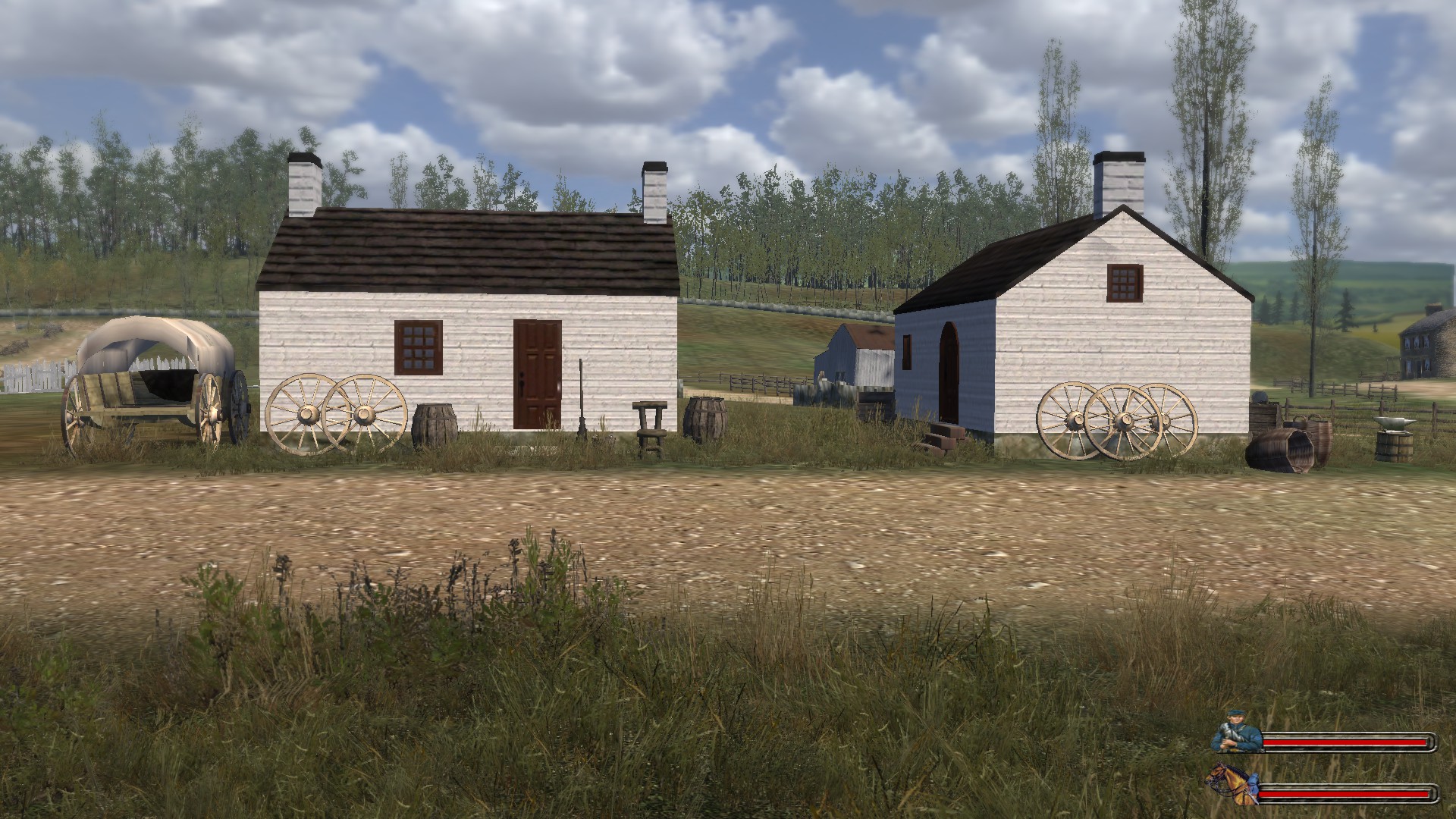
Allen Stratton constructed his wheelwright business on the same property as his home, at the opposite end, where the land abutted Telegraph Road (today's Kirkland Avenue). His business was conveniently located outside the official boundaries of the city of Fredericksburg, on the level ground just before travelers hit rough roads or more hilly country. It was an oasis for repair just before or just after travelers might struggle with wheel related problems. This is somewhat akin to current day vehicle repair businesses that spring up adjacent to major highways, providing needed services to traveling motorists. In the time period of the Civil War, Telegraph Road was the major route out of town going south to Richmond. After the Battle of Fredericksburg, the bullet riddled remains of Stratton's wheelwright and blacksmith were likely turned into firewood by cold Confederate soldiers during the long winter of 1863.
Sisson's Store
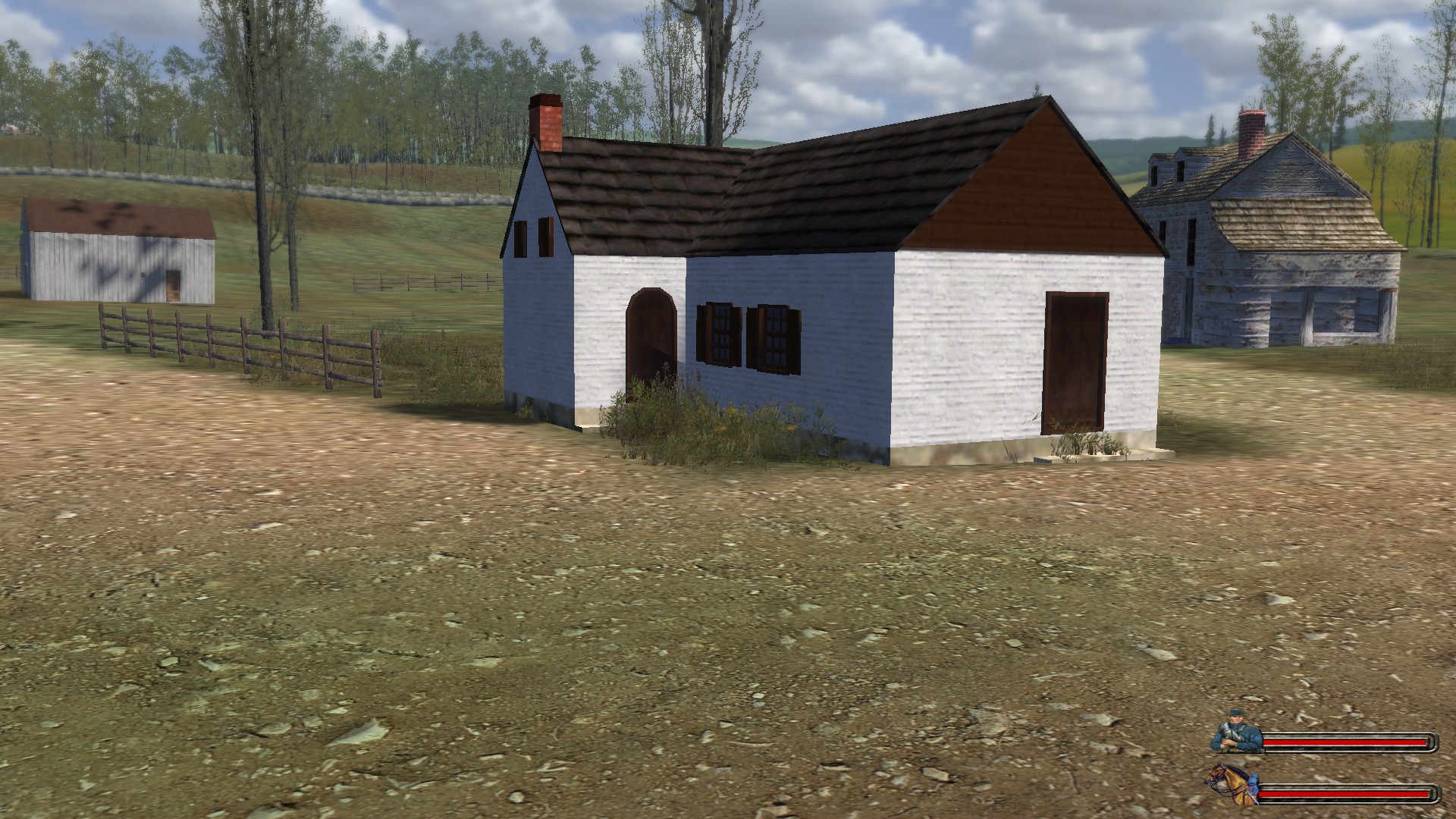
Sisson's store is one of those "lost to history", out of the way localities, which was highly impacted by the Battle of Fredericksburg. National Park Service historian, Noel Harrison, notes that the Civil War era building was torn down in 1893. A lost, or seemingly so, corner of the battlefield, Sisson's store was similar to today's 7-11 convenience stores; it was located in just the right spot to provide services to travelers on their way to or from Fredericksburg. It was located on a triangle of land at the junction of Hanover Street, Telegraph (Sunken) Road and the Swift Run Gap (Orange) Turnpike. Constructed around 1854, it was the home of the Sisson family. Listed as a grocer in the census, David Sisson with his wife Sarah and son Landon provided services to the small surrounding community and passersby. With the addition of the new nearby Fairgrounds, or Mercer Square, life must have seemed to offer boundless possibilities. The structure was made of brick in a T-shape which fit into the road junction. During the 1862 and 1863 battles of Fredericksburg, Sisson's store served as a convenient landmark. The 8th Ohio, was one of the first units in this vicinity. First Lieutenant Thomas Galwey wrote of it in his diary,
"…they entered a small brick grocery… The blunt end of the house which was presented to us was wide enough for a door which we found barred at our approach. A few blows from the butt of a musket opened it and we carried our bleeding comrades in laying them first on the counters and then as their numbers increased, on the floor….Strangest of all we found here a woman, [Sarah?] who, either by accident or a foolhardy desire to save her property had, after barring the door, descended into the cellar… Bullets whistled through it in every direction. Shells exploded, shattering with their terrible detonations every glass in the windows…The wounded began to beg for water…dragged the poor woman out of her cellar. Opening the back door…they forced her out into the pelting shower of missiles to show them the well. She must have gone mad with fear, if she escaped with her life."
Other units also encountered the Sisson's Store throughout the day. All units that ventured out from Hanover Street that day noticed it or were intimately involved with it. The building served both as a place of refuge and a focus of Confederate fire. Even at the end of the day, Union troops were forced to maneuver around it. For Humphrey's two assaulting brigades, it served as the right flank limitation and guide.
Updated Scenes
Washington
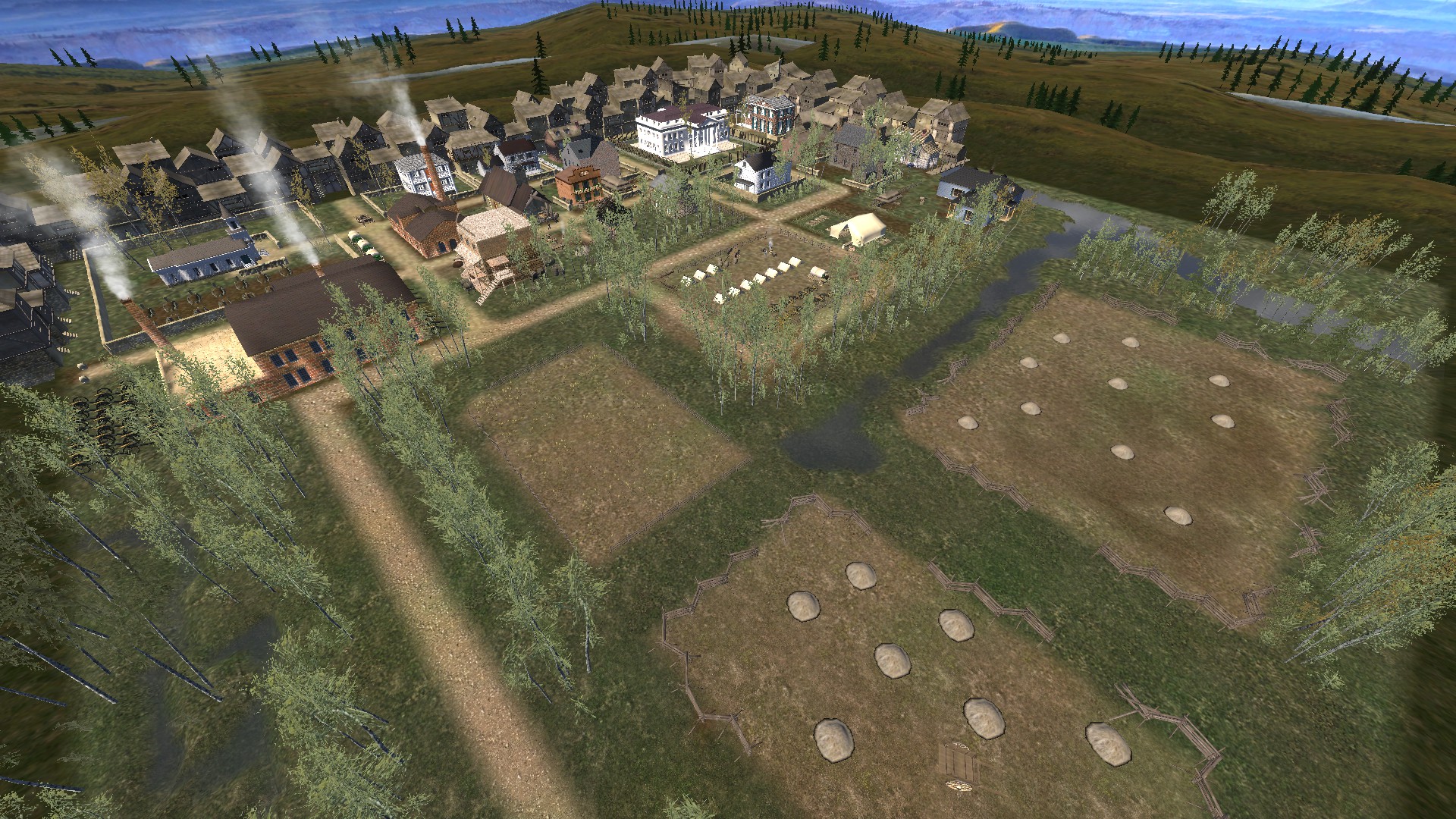
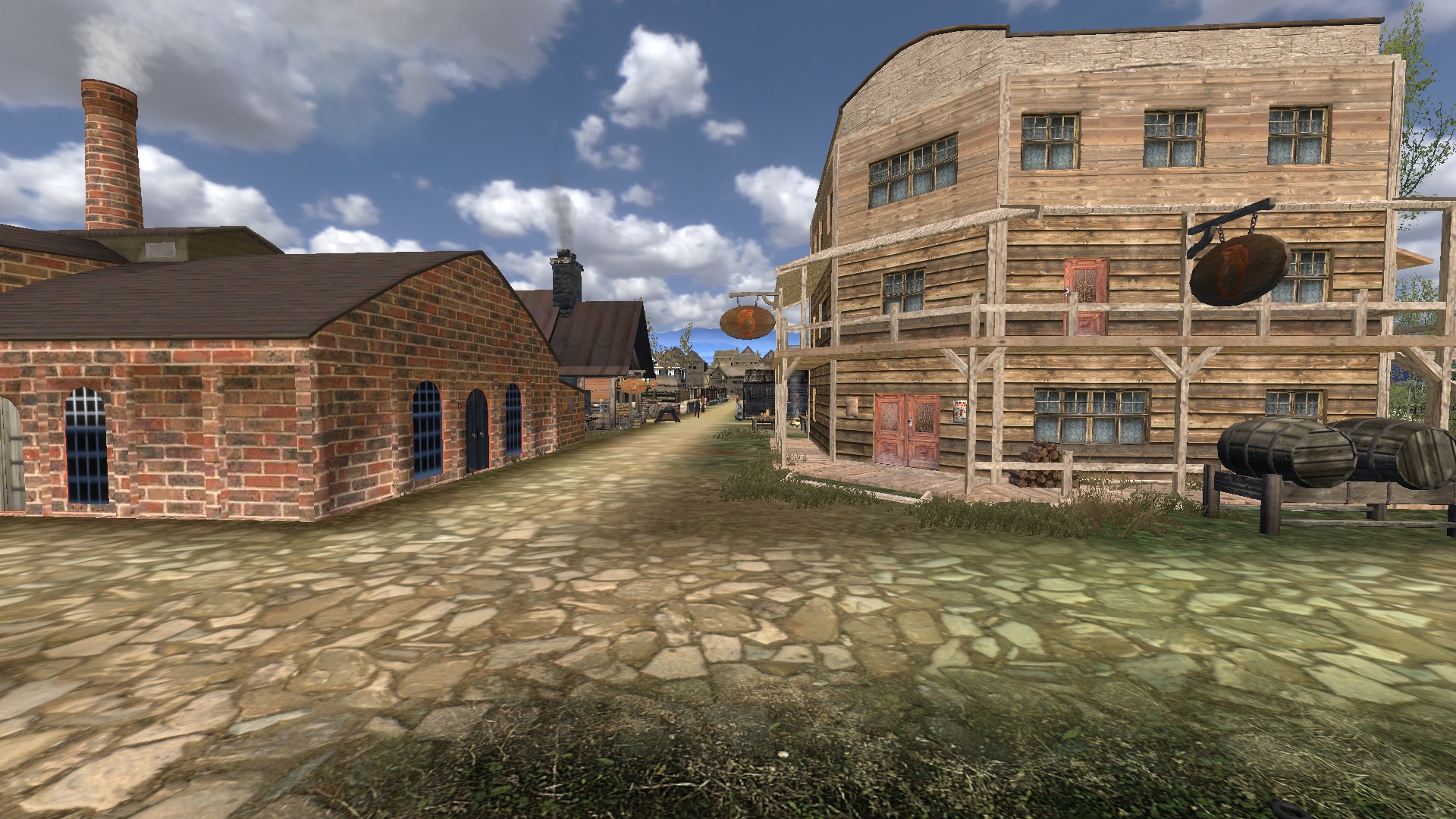
Most of the buildings in the Washington town center scene have been replaced. You will also notice the addition of some new factory buildings, and one very special building in particular...
The White House
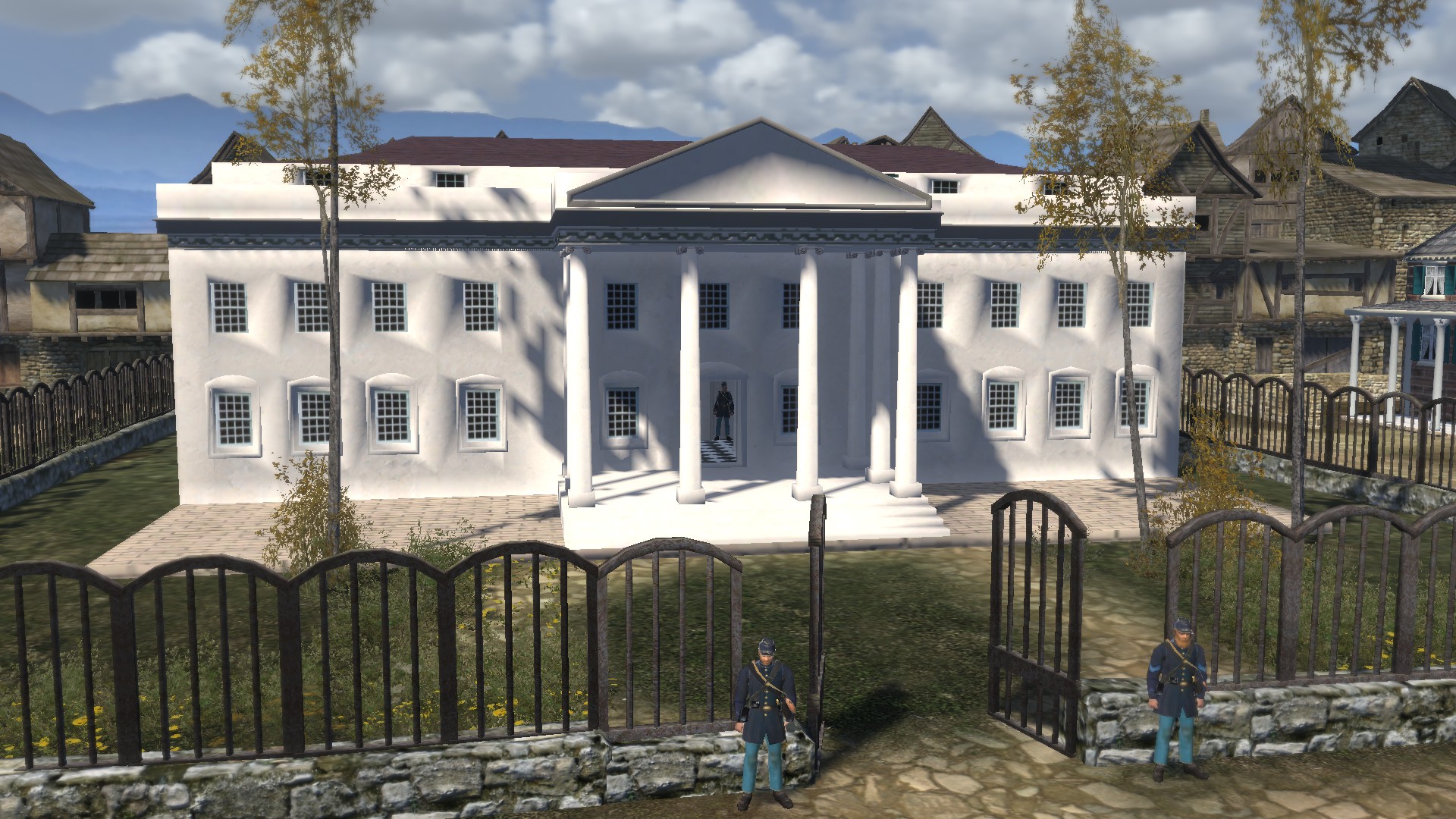
The Executive Mansion needed repairs when the Lincolns moved in. Congress provided every new administration $20,000 for renovations, and Mary Lincoln took charge of the work. No doubt much of this renovation initiative was sorely needed, but Mary overran a generous congressional appropriation allocated for the effort by nearly 30%. President Lincoln swore to the commissioner of public buildings in December 1861 that he would never approve the bills for "flub dubs for that damned old house!", going on to say that it was furnished well enough when they came better than any house they had ever lived in, and rather than put his name on such a bill, Lincoln would pay for it out of his own pocket. Eventually, the overrun was hushed up and made good. Lincoln was not required to make up the difference out of his own pocket after all, and Congress quietly supplemented the appropriation the following year.
One aspect of White House life that made family life particularly difficult for the Lincolns was the mansion's open-door policy to the public. Virtually from Lincoln's first day in office, a crush of visitors besieged the White House stairways and corridors, climbed through windows at receptions, and camped outside Lincoln's office door "on all conceivable errands, for all imaginable purposes." At first, Lincoln rejected his staffs efforts to spare him by limiting public access, but the overwhelming crowds proved too much even for the generous Lincoln to bear, and his staff secured some concessions and organized a formal schedule. Those who were prevented from seeing him left stacks of letters, petitions, pleas, and in some cases, inventions for his inspection. Clerk William O. Stoddard testified that so many newfangled weapons were deposited in the White House office that it came to resemble a gun shop.
In many ways, just as the president had declared, the White House was far better than any place the Lincolns ever lived in. Its family quarters boasted indoor plumbing, gas-fed lighting, separate bedrooms for the children, and a handsome suite and dressing chamber for Mr. and Mrs. Lincoln. The family no longer needed a kitchen, as meals were cooked and served from the White House galley below. Though the Lincoln's Springfield residence had two small parlors and a tiny dining room, and the private quarters upstairs at the White House provided only one common room, which was a combination library, dining area, and parlor called the Oval Room, it proved nearly as large as all three of the rooms in the Lincoln's Springfield home combined. Besides, the Lincolns were free to entertain small or large groups downstairs in the intimate Green, Blue, or Red Rooms, or hold gatherings in the vast East Room, the scene of many public receptions during their four years in residence.
Only a month after President Lincoln's second inauguration, the surrender of Robert E. Lee at Appomattox at last brought the Civil War to an end. But less than a week later, on April 14th, just hours after sharing a carriage ride during which they pledged to each other to be "more cheerful in the future," the Lincolns drove off to see the play, "Our American Cousin", at Fords Theatre. Mary returned to the White House the following morning a widow. She clung to the mansion for five weeks more, unable to summon the strength to leave and cede it to Andrew Johnson and his family until May 22nd, 1865, finally departing in "painful silence," Mary's personal modiste and dresser, Elizabeth Keckly, remembered, "with scarcely a friend to tell her good-bye."
The player can actually walk into the White House from the street, and there will be a passage inside guarded by soldiers that will lead you to the Blue Room and the East Ballroom. We have omitted the Green Room from the interior scene to save on space and keep the characters more close together during large gatherings. These scenes also include new props and furniture appropriate to the time period.
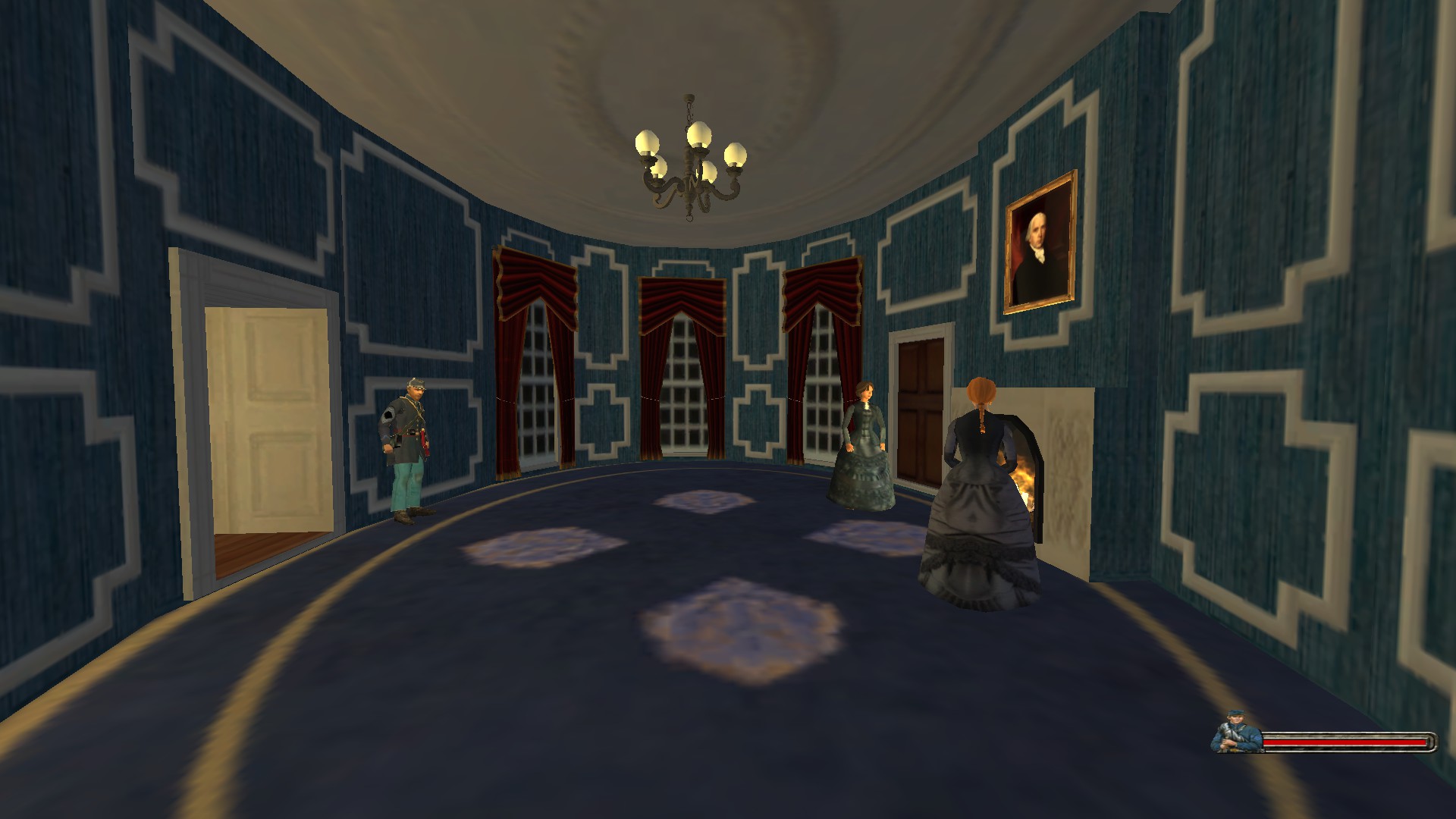
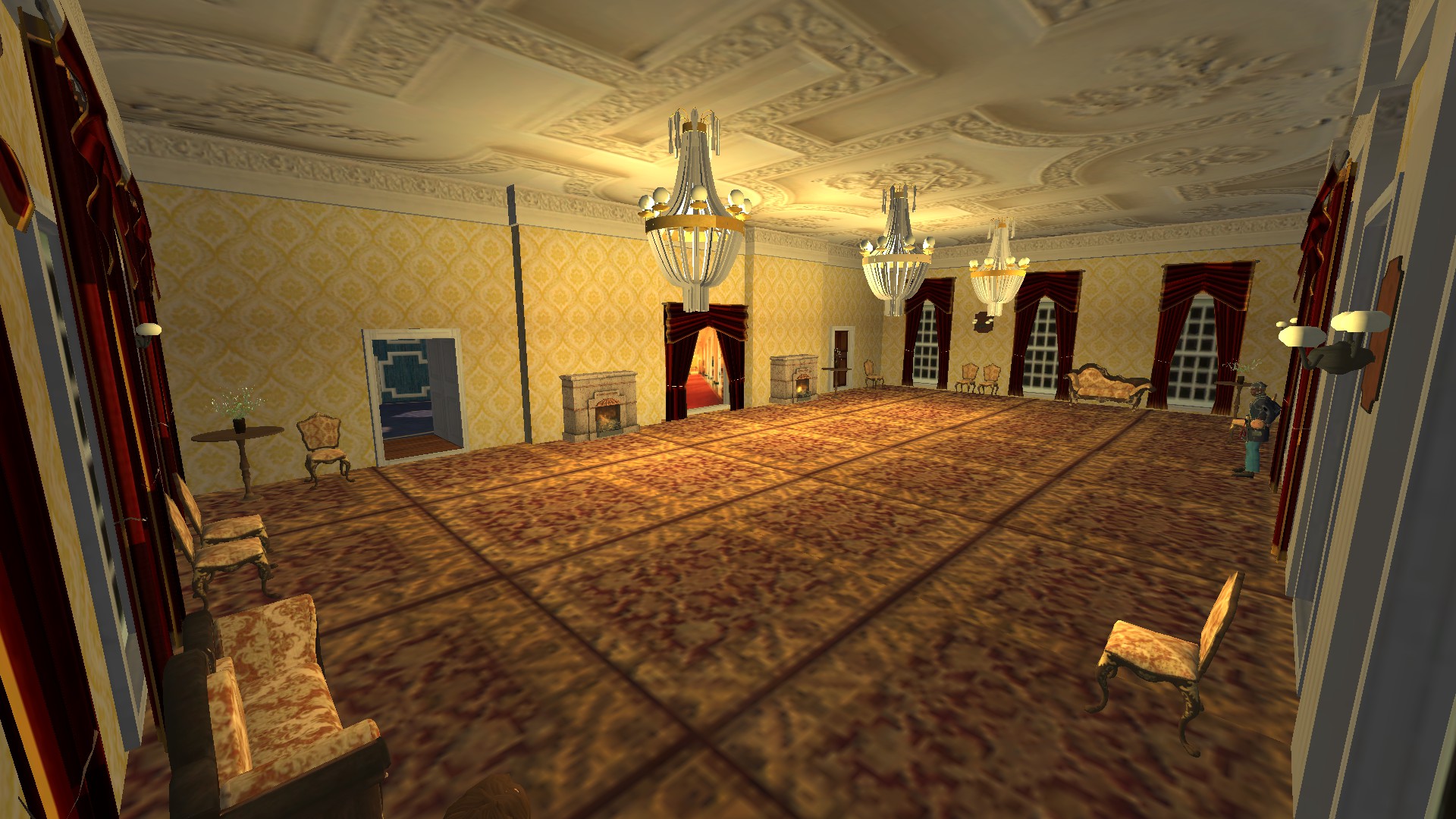
Richmond
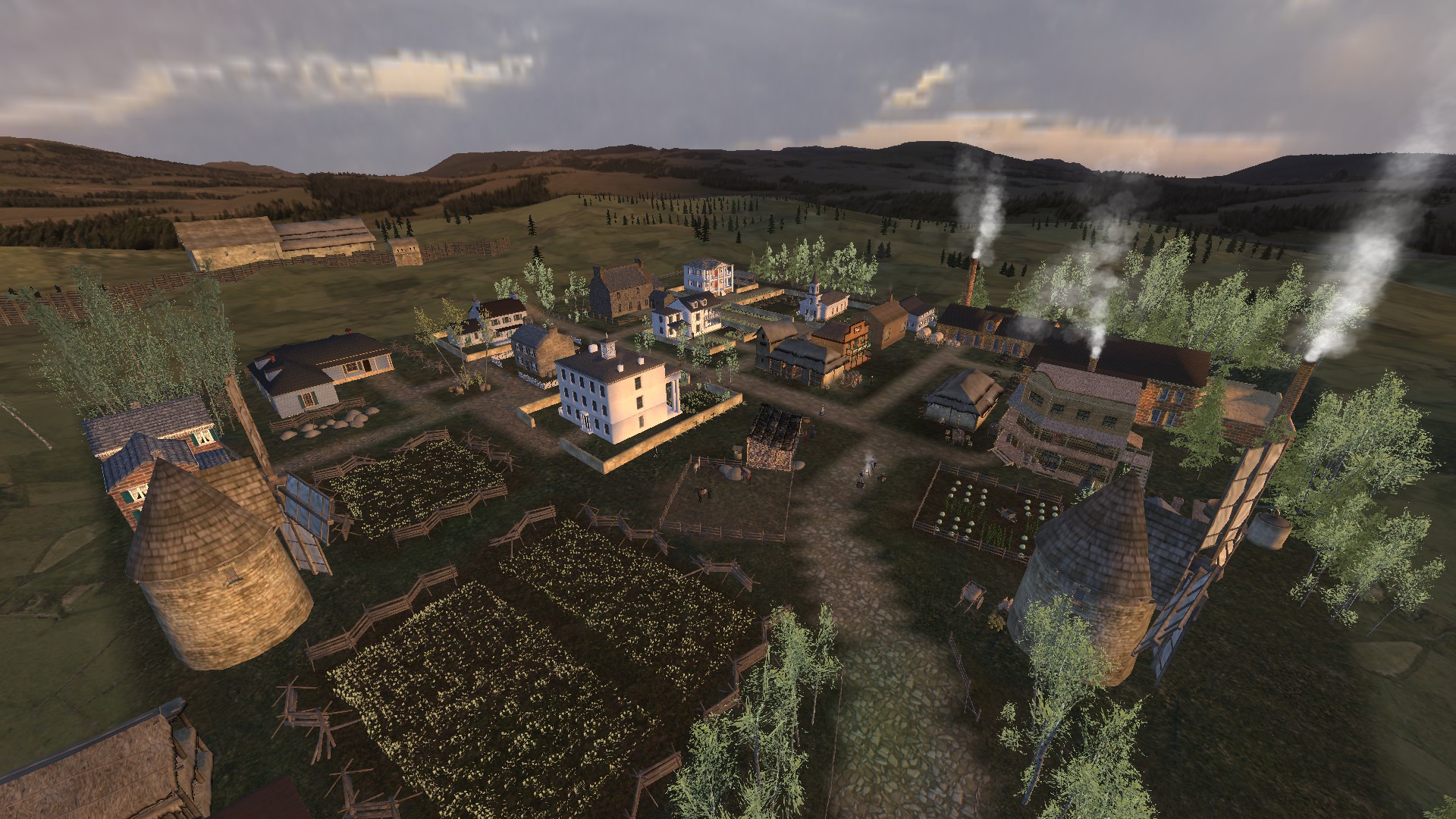
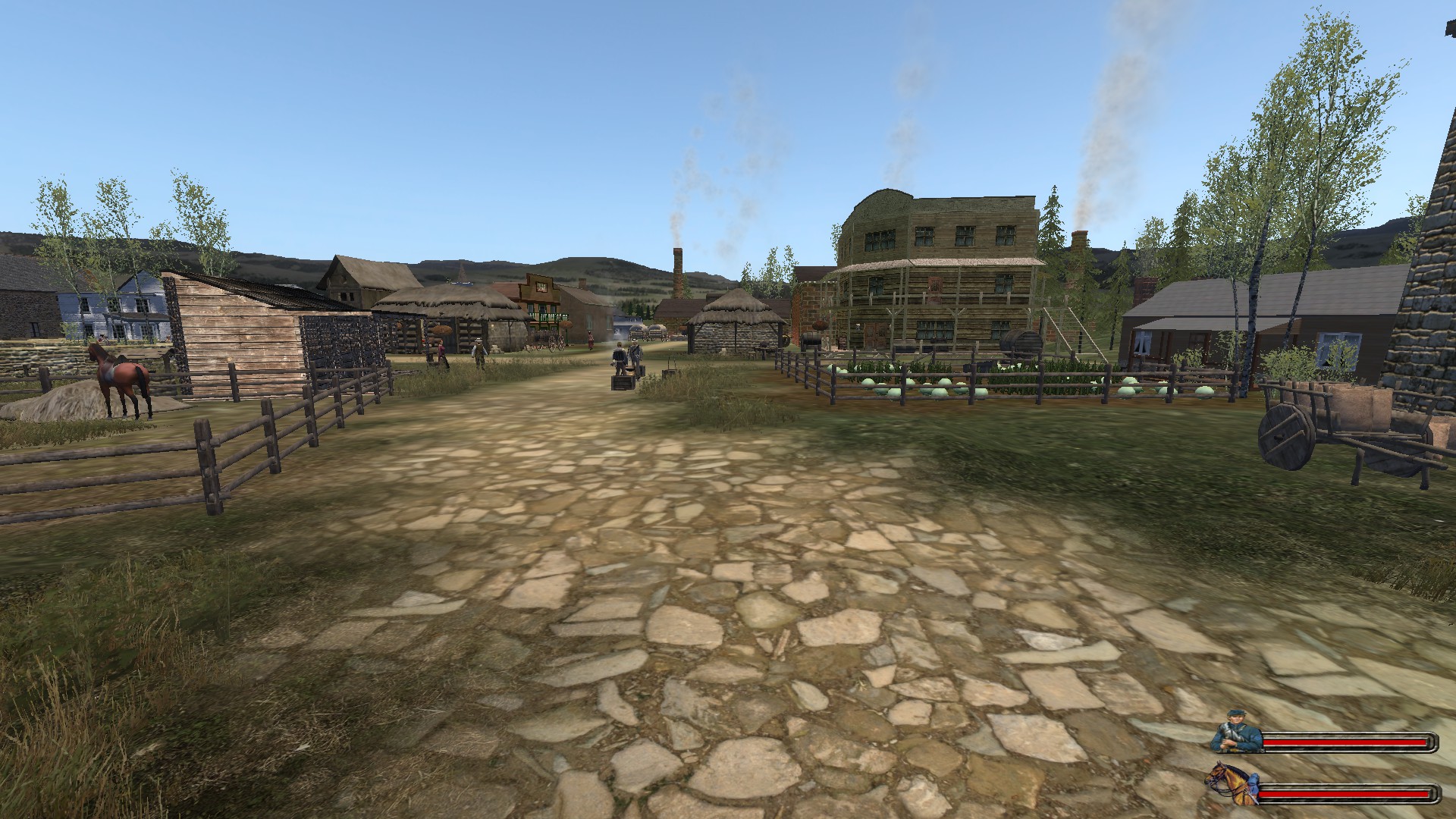
Almost all the buildings in Richmond have also been replaced, except for the weapons and clothing merchants, which we have plans to update in the future with custom buildings for the stores with open interiors that can be walked inside of. There is also another important landmark in Richmond...
The Jefferson Davis Executive Mansion
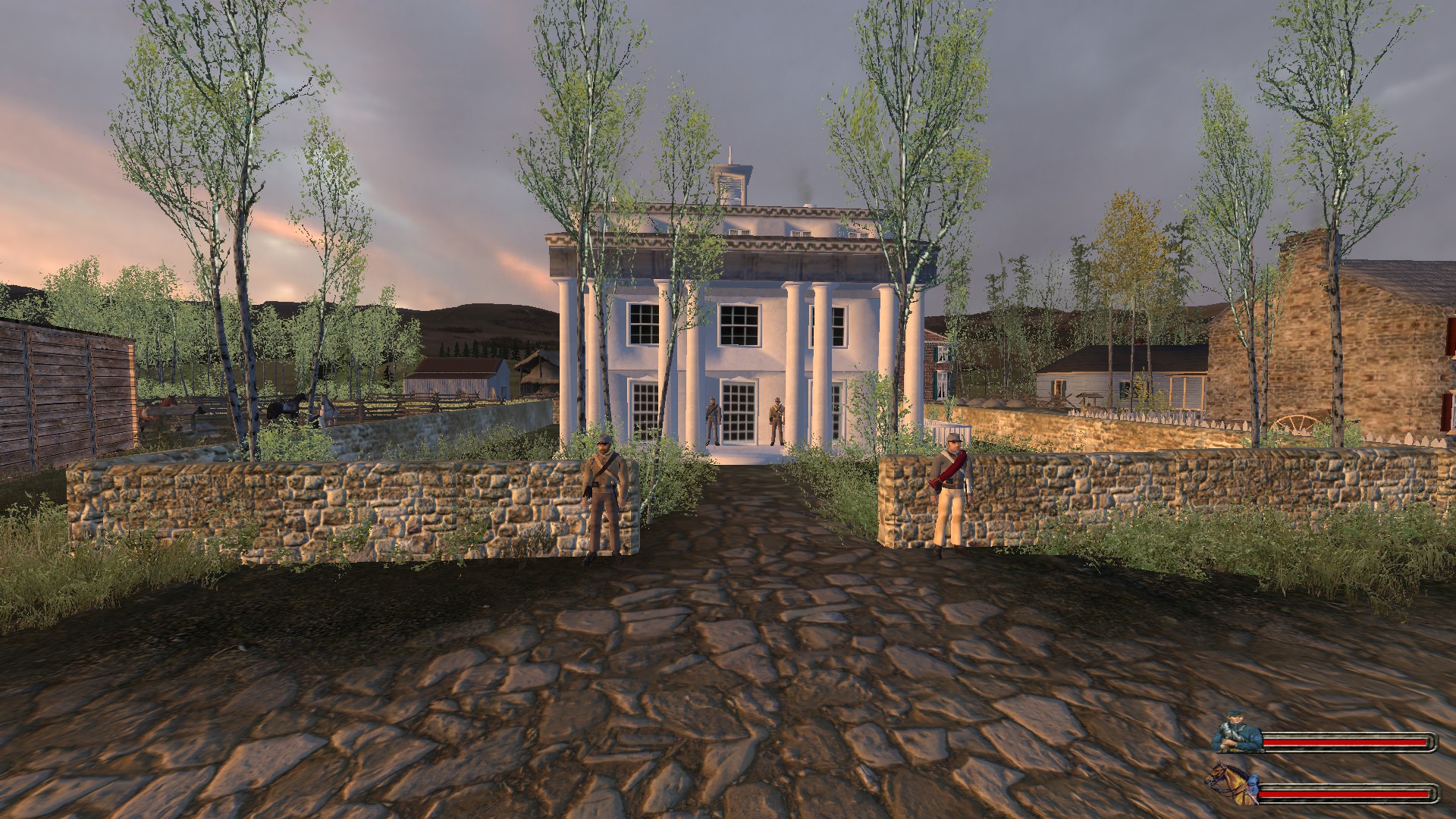
This was the main executive residence of the sole President of the Confederate States of America, Jefferson Davis, from August 1861 until April 1865. It was viewed as the Confederate States counterpart to the White House in Washington. The first White House of the Confederacy in Montgomery, Alabama, was the first official residence of the Confederate president and his family. The second White House of the Confederacy is a gray stuccoed neoclassical mansion built in 1818 by John Brockenbrough, who was president of the Bank of Virginia. Sold by the Brockenbrough family in 1844, the house passed through a succession of wealthy families throughout the antebellum period, including U.S. Congressman and future Confederate Secretary of War James Seddon. Just prior to the American Civil War, Lewis Dabney Crenshaw purchased the house and added a third floor. He sold the home to the City of Richmond, which in turn rented it to the Confederate government as its Executive Mansion.
Jefferson Davis, his wife Varina, and their children moved into the house in August 1861, and lived there for the remainder of the war. Davis suffered from recurring bouts with malaria, facial neuralgia, cataracts in his left eye, unhealed wounds from the Mexican War, and insomnia. Consequently, President Davis maintained an at-home office on the second floor of the house. The house was abandoned during the evacuation of Richmond on April 2nd, 1865. Within twelve hours, soldiers from Major General Godfrey Weitzel's XVIII Corps seized the former Confederate White House, intact. President Abraham Lincoln, who was in nearby City Point (now Hopewell, Virginia), traveled up the James River to tour the captured city, and visited Davis' former residence for about three hours. President Lincoln only toured the first floor, saying that he felt it would be improper to visit the more private second floor of another man's home.
This building in the mod also includes a custom interior that is based upon the actual floor plan for the real life structure. Like the White House in Washington, the player will now be able to enjoy an immersive and authentic atmosphere in which to meet with the generals and ladies.
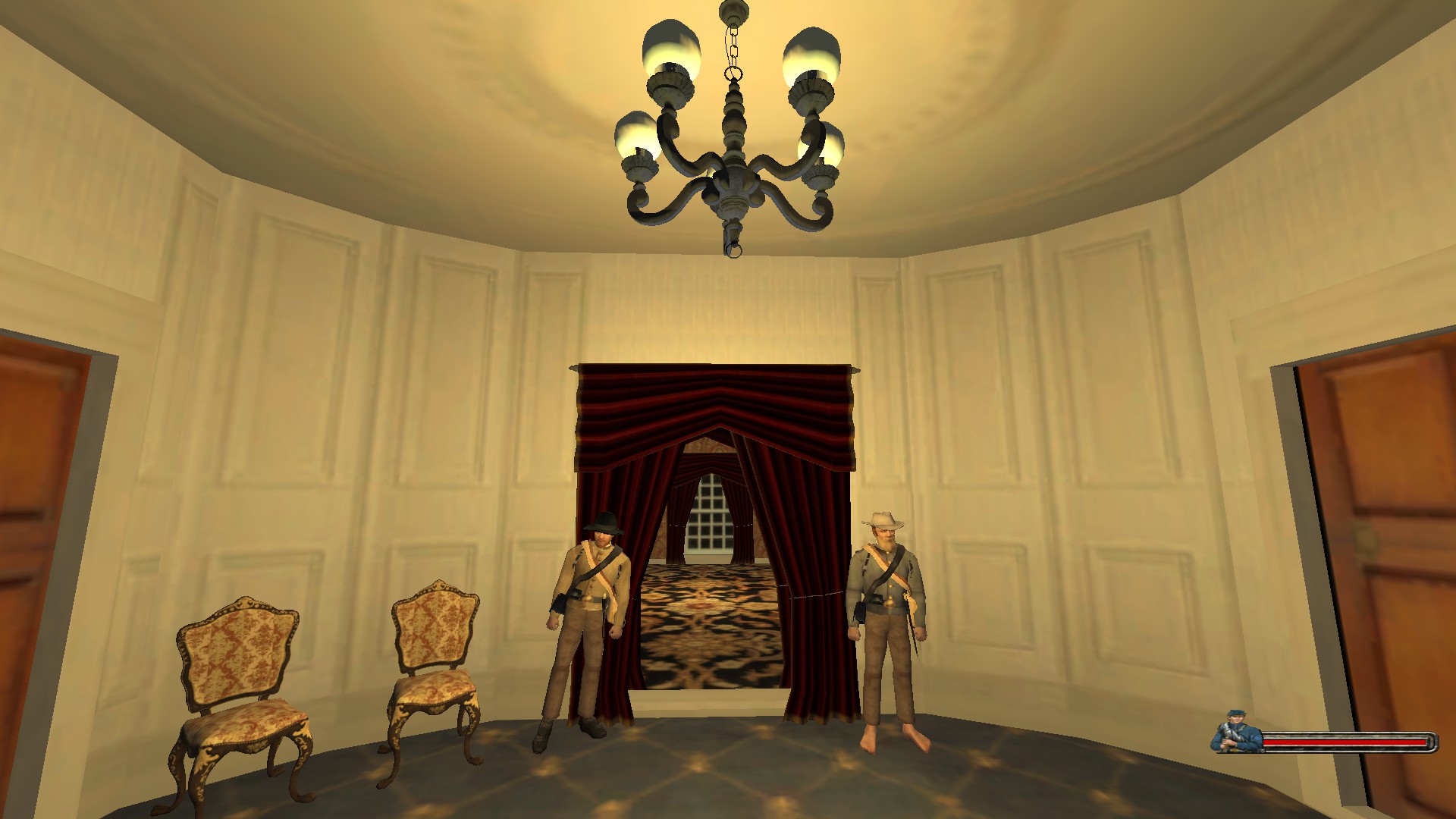
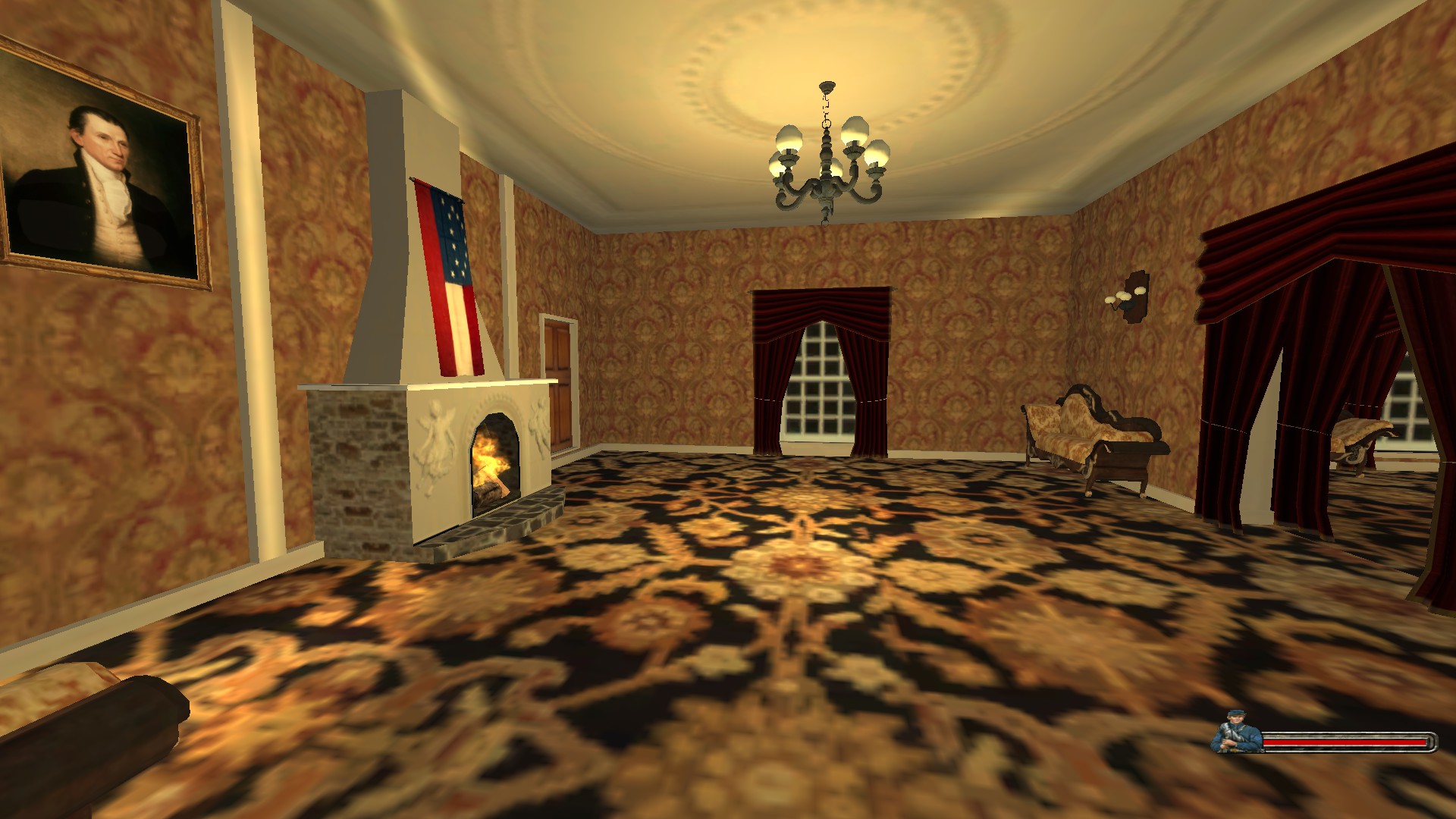
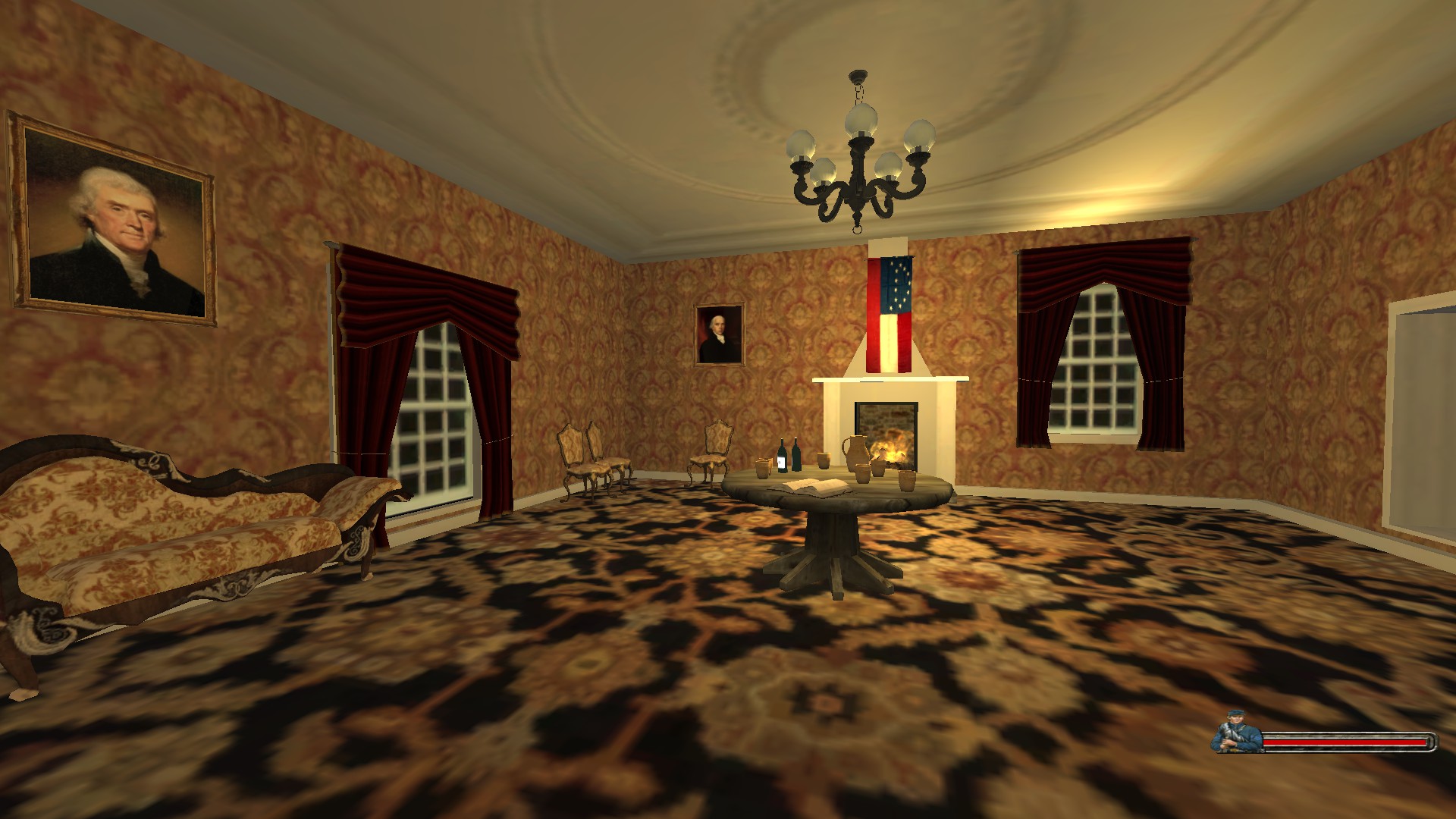
New Village Scenes
Here you can see how the villages look with their buildings replaced. These are not replicas of the real life locations, but are made to feel more in line with the time period by replacing all of the medieval looking structures.
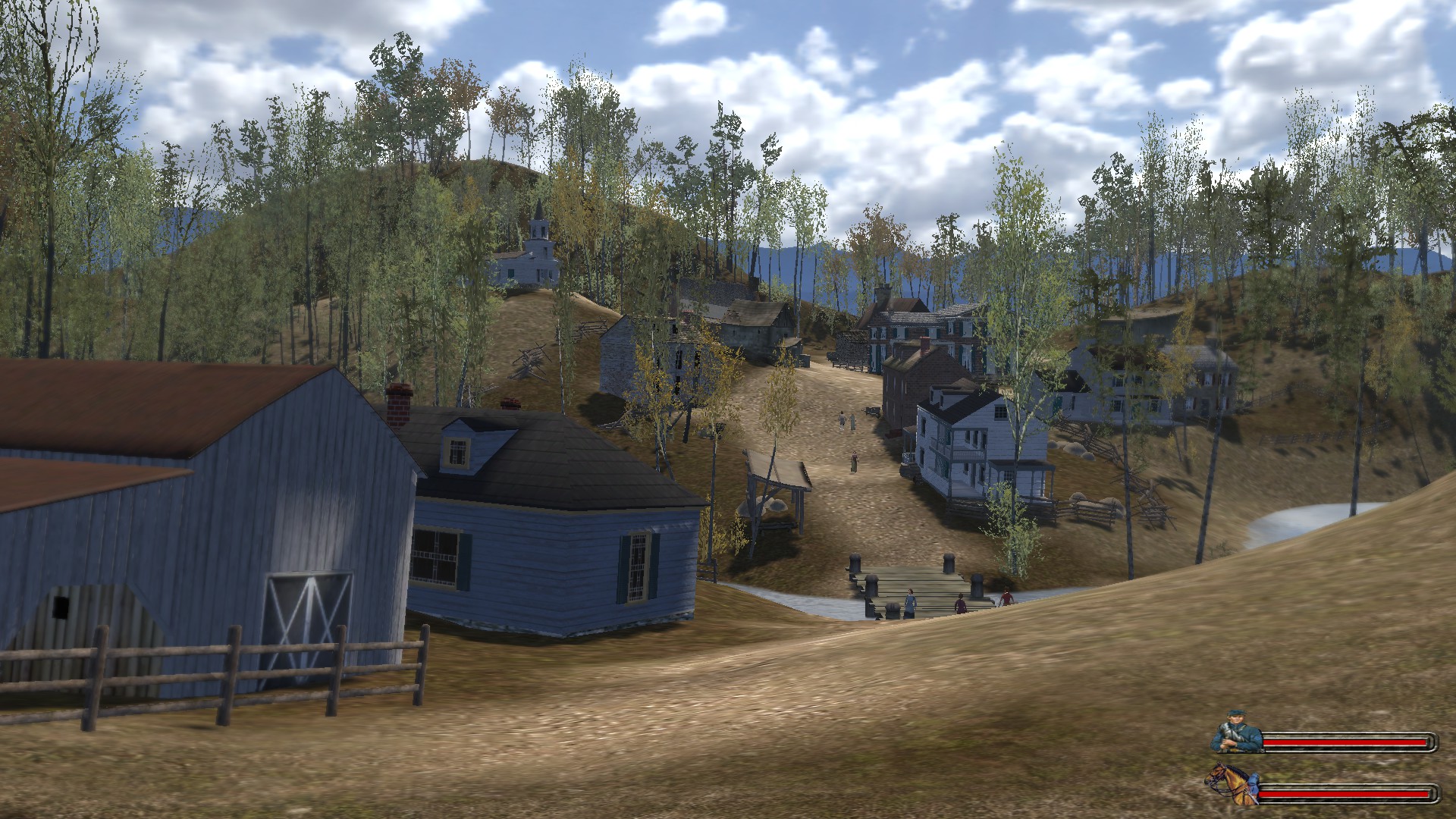
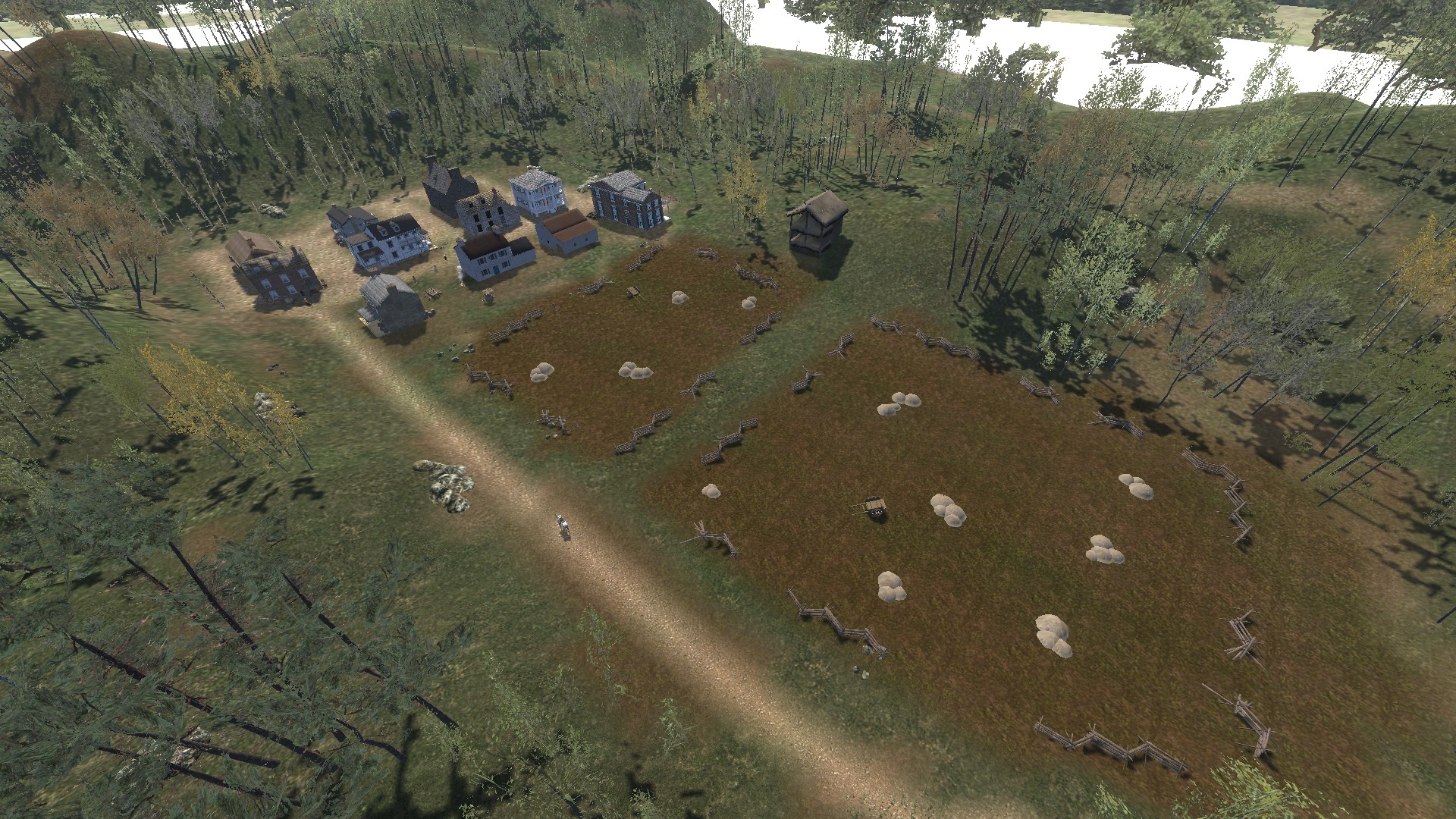

One of the more exciting pieces of news we have is that we have learned how to make the AI navigate scenes properly, so they do not get stuck on fences and buildings. There is a tool in the game's editor called an AI mesh, and this is basically a grid on the map that tells the AI where it can and cannot walk. The process for creating an AI mesh is rather tedious though, so each scene will need to be worked on individually and progress will be slow in this regard. Scenes that already have a working AI mesh are the new Sharpsburg and Fredericksburg battlefield scenes, as well as a number of the more frequently visited villages, some of which include Mount Sterling, Parkersburg, and Lynchburg, among others.
Native American Tipi Props
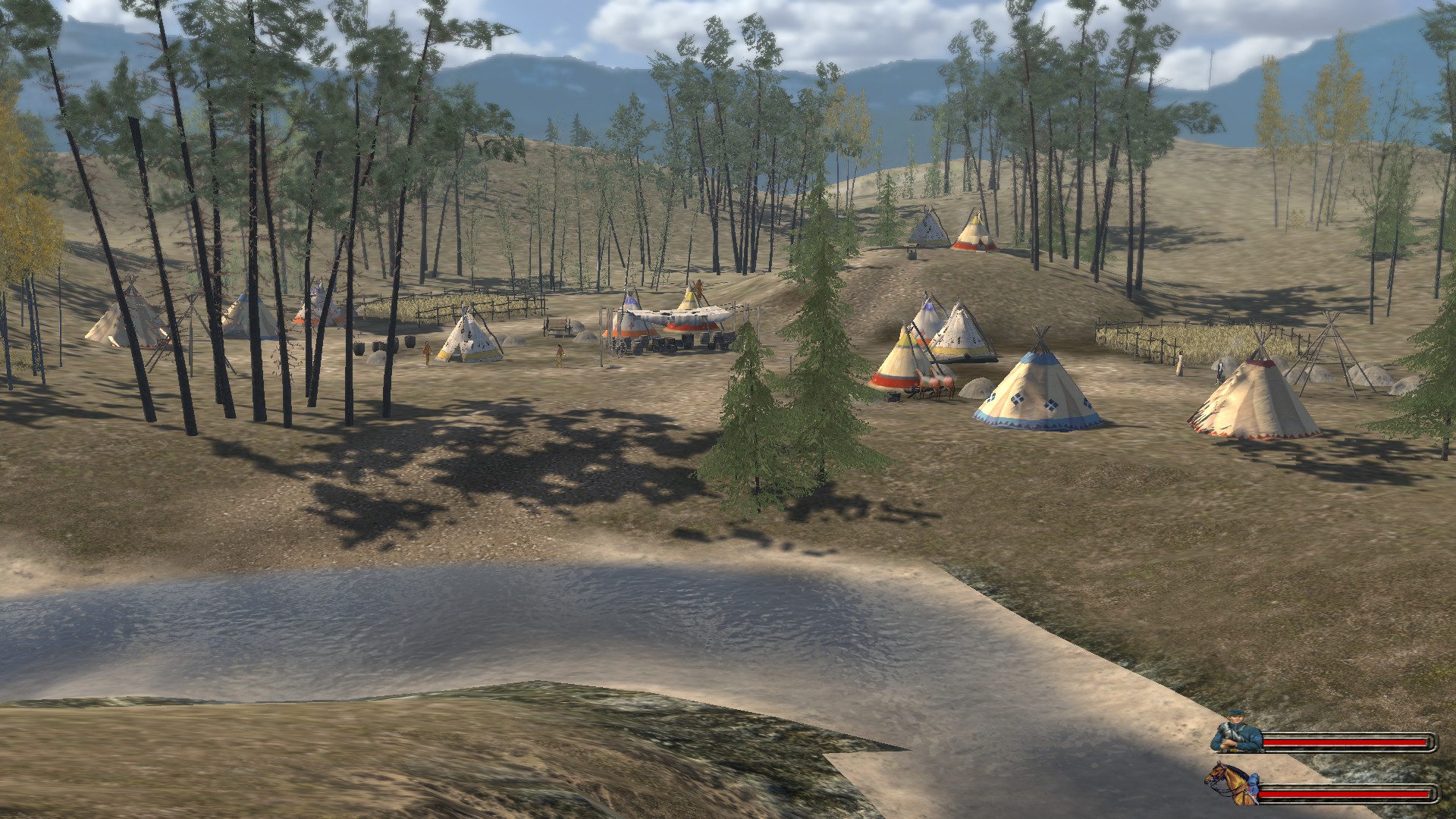
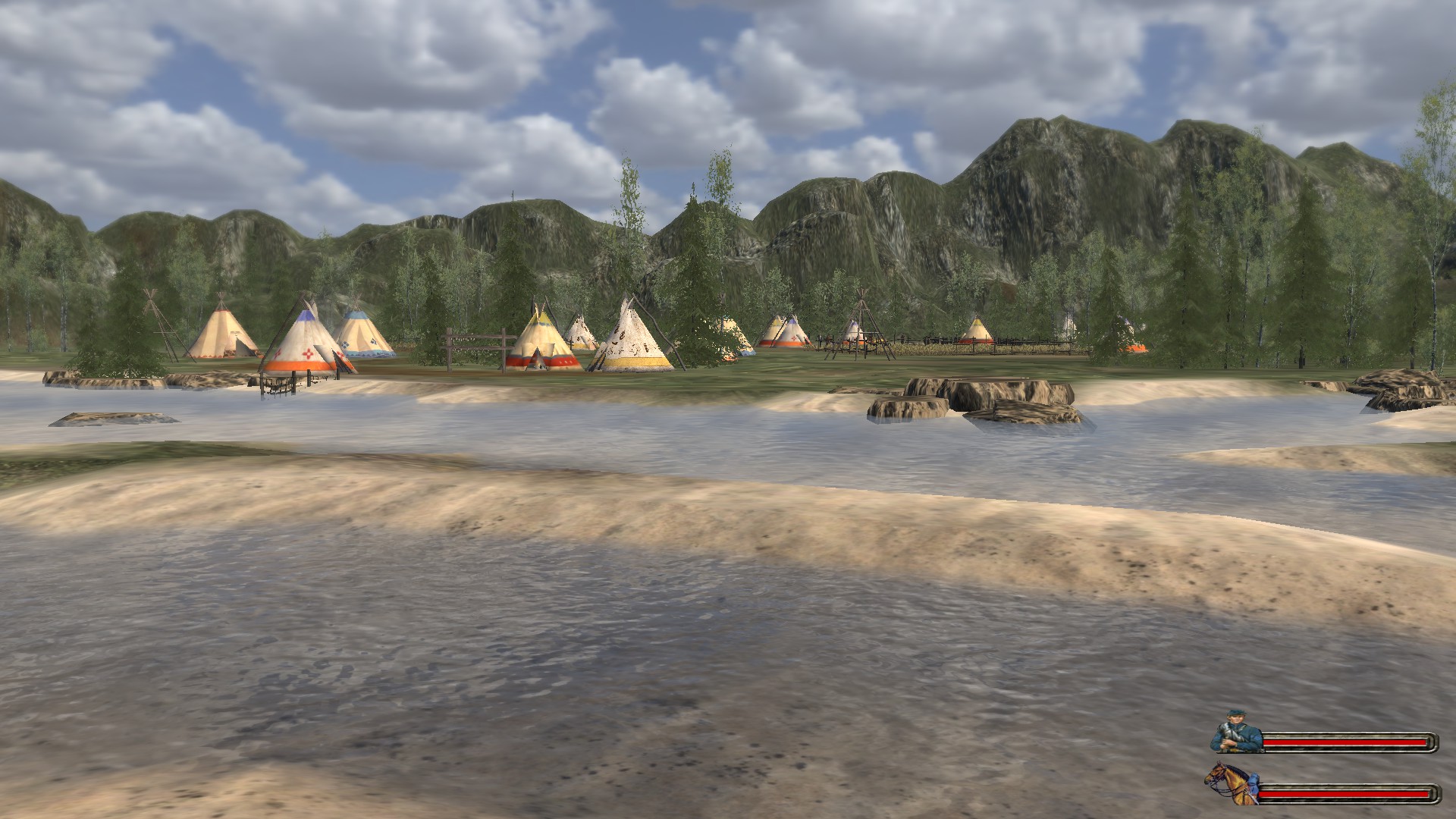
New props for Native American tipis have been added to some of the Plains Indian Tribe's scenes. Not all of the scenes are finished, but what is done is a good proof of concept.
New Union Cavalry Regiment
3rd New Jersey Cavalry "The Butterfly Hussars"
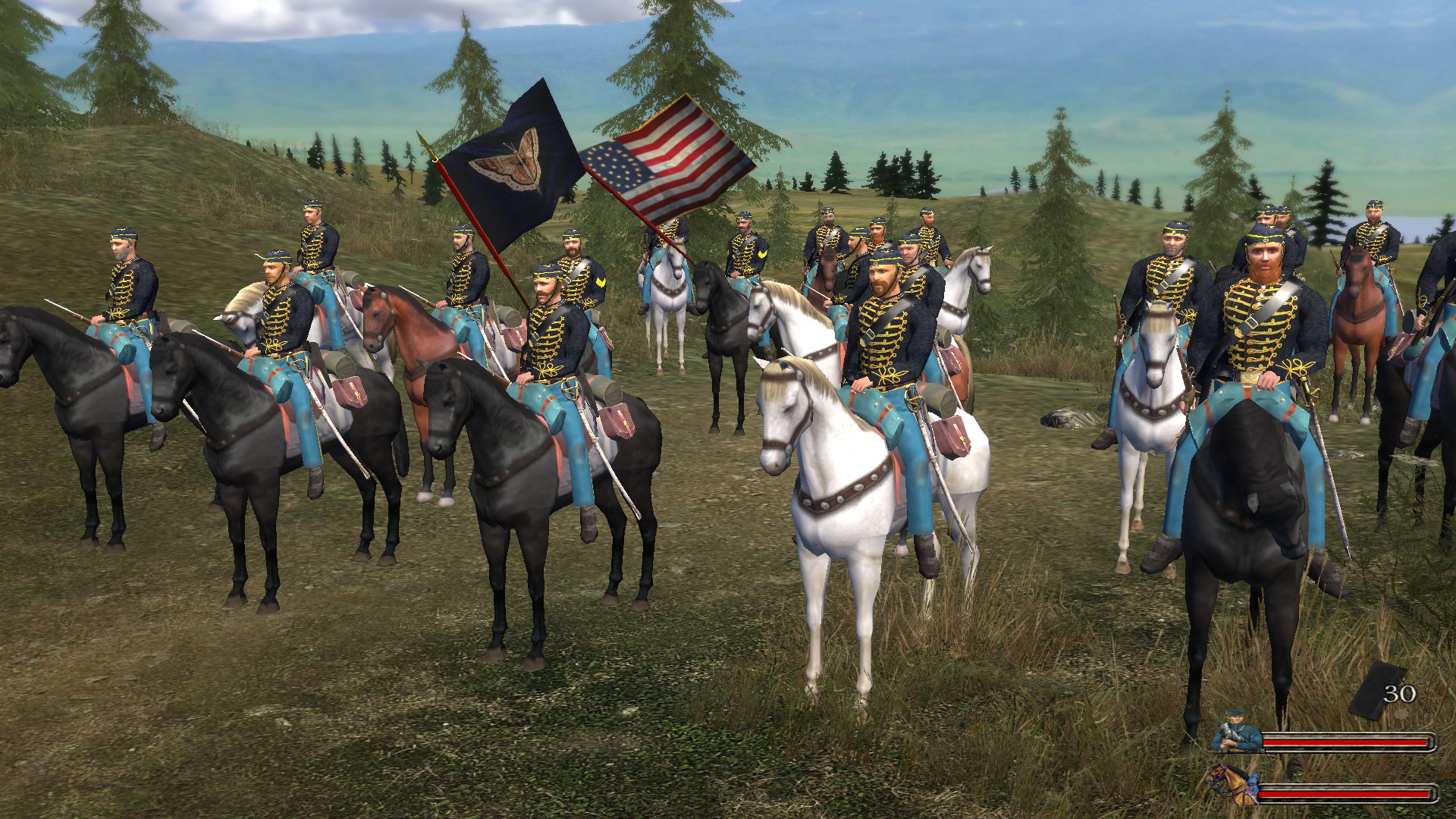
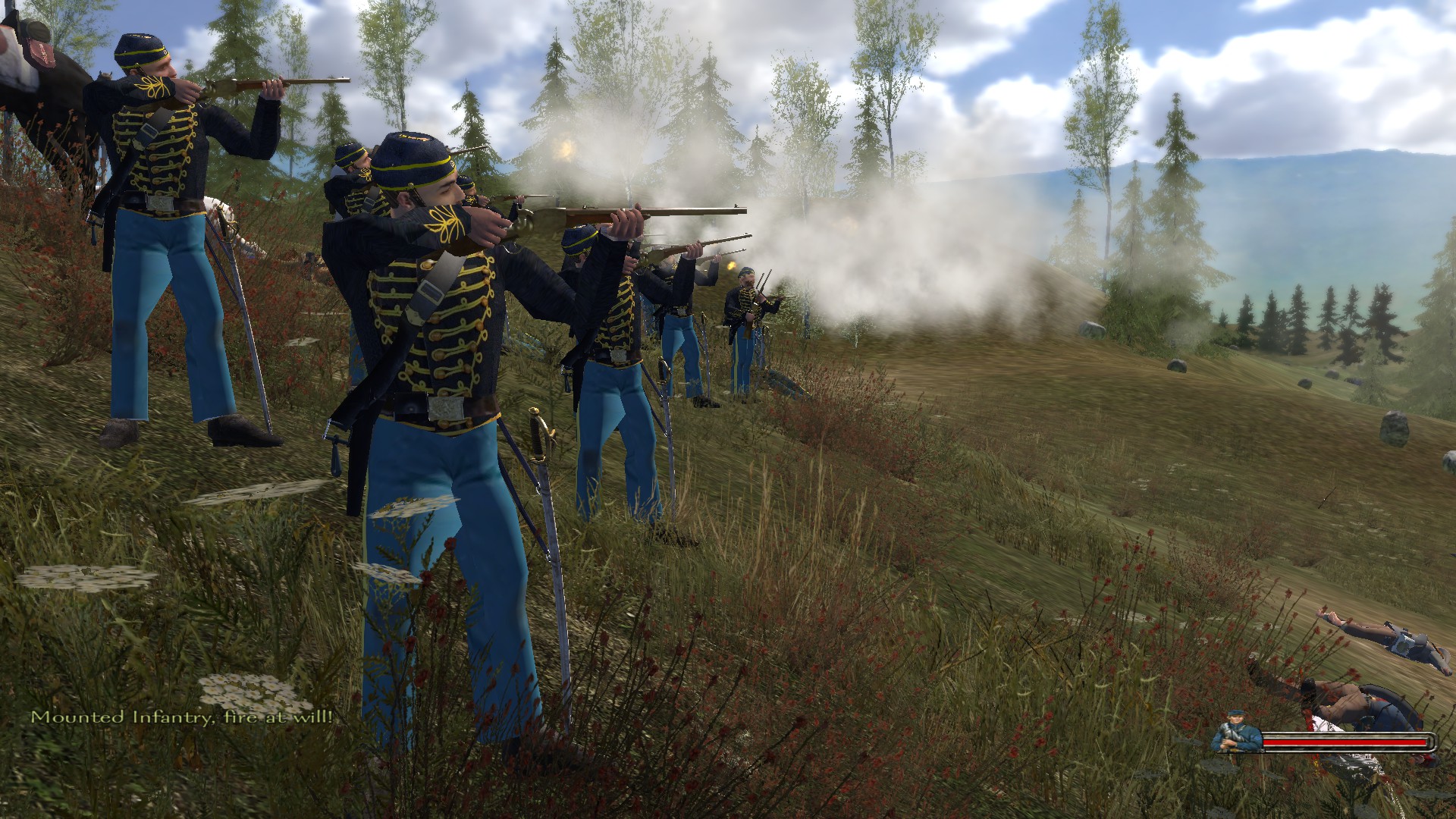
The 3rd New Jersey Cavalry Regiment was organized at Camp Bayard in Trenton, New Jersey, recruited during the winter of 1863-64, and was mustered into United States service on February 10th, 1864, under the command of Colonel Andrew J. Morrison. The unit is an intriguing one that featured an ethnic mix of predominately German and Irish immigrants, as well as soldiers from more than a half dozen other European countries. They were also known by several nicknames, such as the First American Hussars as well as the Butterfly Boys and the Fighting Butterflies; their creation by an alcoholic ex-officer of the Union Army was supposed to entice men to join a galloping, dashing, romantic cavalry unit, with a unique uniform based on the elegant hussars of Europe that included a hood and cape, and carrying a flag into battle that featured a butterfly.
The 3rd New Jersey Cavalry left Trenton on March 29th, 1864, 1,200 strong, marching by way of Philadelphia and Wilmington to Perryville in Maryland, where it embarked on steamers and proceeded to Annapolis, being there attached to the IX Corps. The enemy being gradually compelled to fall back before the operations of General Ulysses S. Grant, the regiment pushed forward with its brigade, sharing in the operations at Ashland, Old Church and other points, and showing the highest soldierly qualities in all the actions in which it participated. Up to the middle of July, its total losses in killed, wounded and missing amounted to 76. On July 16th, the 3rd New Jersey was transferred to Lighthouse Point, but on the 25th it returned to its old position, and two days later lost several men from guerrillas while on picket duty, one man being killed, two wounded and two captured. At the Battle of Winchester its total loss was 130 men, the killed including one captain and one lieutenant. In the operations at Summit Point the regiment lost six killed, 25 wounded and 14 missing. At Kearneysville its loss in wounded and missing was 30 men, and in the affair on the Berryville Turnpike in September its loss was one killed. After this, the regiment lay quiet until the 19th, when it participated in the Battle of the Opequan, suffering some losses, but not sufficient to disturb their elation over the grand achievements of the day.
It was again engaged at Front Royal, losing some men, and on the 28th, being in the cavalry advance, it once more encountered the enemy at Waynesboro, where it suffered a loss of 10 men killed and wounded, but fought with its accustomed gallantry. In the retrograde movement which followed, a movement designed to draw the enemy once more within effective striking distance, the regiment again proved its efficiency at Bridgewater, losing 9 men; at Brock's Gap, and at Tom's Brook, where it had a severe engagement with the now pursuing foe, its loss in that action being 8 men. Finally reaching Cedar creek, it went on picket, where it remained until the 13th, when it had a sharp fight, losing 10 men. In the memorable Battle of Cedar Creek it was early placed in position, but was only moderately engaged. In the subsequent operations in the Valley it had an honorable part, being engaged on the Back Road and at Mount Jackson, the loss of the command in the latter engagement being 10 men killed and wounded.
In the spring of 1865, the 3rd New Jersey was variously engaged in the vicinity of Petersburg until the last grand assault upon the Confederates. During the Battle of Five Forks, fighting again with the scarred veterans who had swept Early from the Shenandoah Valley, the regiment displayed conspicuous gallantry, sharing in all the perils as well as the splendid achievements of that day, on which the power of the Confederacy was finally and forever broken. The loss to the regiment was only 8 wounded, including Lieutenant Colonel Robeson. Joining in the pursuit of the fleeing Confederates, the regiment lost two officers wounded in a skirmish on the 6th, but was not again heavily engaged. In due time Robert E. Lee surrendered and the Confederate armies dissolved. The regiment proceeded to Washington and participated in the Grand Review, and was mustered out of service on August 1st, 1865. The total strength of the regiment was 2,234, and it lost during its term of service by resignation 17, by discharge 83, by promotion 47, by transfer 276, by death 145, by desertion 439, by dismissal 8, not accounted for 187, and mustered out 1,032.
In the mod:
The 3rd New Jersey Cavalry wear their elegant and unique hussar uniforms and come with a dolman style hat that comes in two versions, with the chin strap around the chin and also up on the hat. Their appearance makes them the only mounted unit available to the Union that has a distinct looking uniform. As of right now, all the others wear a standard issue cavalry uniform, except for Wilder's Lightning Brigade, but they are simply mounted infantry and their uniforms are those of standard light infantrymen. The troopers of the 3rd New Jersey are equipped with Spencer Carbines and cavalry sabers, making them a powerful mounted unit that is arguably better than Wilder's Lightning Brigade, due to the fact that they can fire their 7-shot Spencer Carbines from horseback, while Wilder's Brigade must dismount to use their Spencer Rifles. Though the regiment is well dressed and well equipped, be mindful of their ammunition. Ordering the unit to fire at will can easily lead to the rapid exhaustion of ammunition supplies, as the rate of fire for the Spencers are much faster than muzzle loading rifles or breech loading carbines. The most effective use of units armed with Spencers is actually taking a page from history, and using them to fire in controlled volleys, whereby the lack of a need to reload between each shot can present a deadly firing line towards the foe and create a serious advantage over them. While the enemy is forced to reload after each volley, you can continue to fire seven more times and the reloading process is quite fast. The 3rd New Jersey Cavalry can be found under the Army of the Mississippi as an upgrade from the Union Veteran Mounted Infantry.
New Projectiles
One of the more exciting things that we have recently accomplished is the creation of several new types of projectiles that will be fired from all of the firearms in the mod. It is not really visible in the heat of battle, but you will sometimes notice actual bullets whizzing past you now. If you pause the game with ctrl + F11, and use the editor camera (ctrl + E, then press H and drag the toolbar into the bottom corner of the screen to get it out of the way. You can also use ctrl + F9 to slow down time.), you can follow the direction that the soldier's are firing in and if you look carefully, you will find these new bullets flying through the air! They are too fast to be seen in real time or even in slow motion, but when time is stopped, the player with a keen eye can see in a moment the bullets being exchanged.
Before, there wasn't any projectile being fired from the guns actually; it was just an invisible mesh, and it essentially came down to numbers and mathematic equations deciding the day's battle rather than bullets. Now that there are actual Minié balls flying in the air that can even be seen when examined closely, it really brings things to a whole new level detail in the mod.
.58 Caliber Minié Ball
The Minié ball is a type of muzzle loading spin-stabilized bullet for rifled muskets named after its developer, Claude-Étienne Minié. It is a conical bullet with three exterior grease filled grooves and a conical hollow in its base. The French army never adopted the Minié bullet, but the British War Ministry was sufficiently impressed with the design, paying Minié a royalty of 20,000 pounds in 1852 for his patent to use the ammunition. During the Crimean War, the bullet reportedly so improved the effectiveness of infantry troops that 150 soldiers using the Minié could equal the firing power of more than 500 men armed with a traditional smoothbore musket and round ball ammunition. The London Times called the Minié, "the king of weapons" that swept through the ranks of the Czar's soldiers "like the hand of the Destroying Angel."
The United States had observers present during the 1853–1855 Crimean War, including the future commander of the Army of the Potomac, George B. McClellan. The Minié ball came to America, where it was improved upon by Captain James H. Burton, an armorer at the Harpers Ferry Armory, who developed an improvement on Minié's design when he added a deep cavity at the base of the ball, which filled up with gas and expanded the bullet's rim upon firing. The result was not only better range, but also a cheaper bullet. Burton's version of the new ammunition, along with the rifled musket for firing it, was adopted for use by the U.S. Army by Secretary of War Jefferson Davis, the future president of the Confederate States of America. Both the American Springfield Model 1861 and the British Pattern 1853 Enfield rifled muskets, the most common weapons used during the American Civil War, used the Minié ball. When the rifle was fired, the expanding gas pushed forcibly on the base of the bullet, deforming the skirt to engage the rifling. This provided spin for accuracy, a better seal for consistent velocity and longer range, as well as cleaning the barrel.
Wounds inflicted by the conical Minié ball were different from those caused by the round balls from smoothbore muskets, since the conical ball had a higher muzzle velocity and greater mass, and easily penetrated the human body. Round balls tended to remain lodged in the flesh, and they were often observed to take a winding path through the body. Flexed muscles and tendons, as well as bone, could cause the round ball to deviate from a straight path. The Minié ball tended to cut a straight path and usually went all the way through the injured part; the ball seldom remained lodged in the body. If a Minié ball struck a bone, it usually caused the bone to shatter. The damage to bones and resulting compound fractures were usually severe enough to necessitate amputation. A hit on a major blood vessel could also have serious consequences, many times resulting in the death of the injured. The Minié bullet could sever limbs, tear men apart and when a Minié ball entered the human body, it could carry with it any foreign matter it picked up from the uniform, which meant there was a greater risk of infection. According to Confederate surgeon Deering Roberts, "The shattering, splintering, and splitting of a long bone by the impact of the Minié… ball," Roberts recorded, was, "both remarkable and frightful". In his memoir, "The Surgeon and the Hospital in the Civil War", Albert G. Hart noted that whereas a round ball might be deflected from a thigh bone with no serious injury, a Minié bullet, "under similar conditions might not only fracture, but crush two or three inches of the bone".
The long range accuracy of the Minié ball meant that the traditional model of warfare, where infantry and cavalry assaults could be successful, was effectively over. Weapons of an earlier age, such as the bayonet, became almost obsolete in this new kind of warfare, and the role of cavalry and field artillery was greatly reduced. The smoothbore musket had an effective range of 50 yards and an extended range of 200 yards. The rifled musket increased the lethality of ranged combat by providing an effective range of 300 yards, with an extended range of a half mile. No longer could artillery crews set up just outside musket range to deliver devastating grapeshot or canister fire, as they had done during the Napoleonic Wars, because the rifled musket could easily pick off those crews if they were within the 300 yard range of canister. According to the, "Medical and Surgical History of the War of the Rebellion", published by the U.S. government between 1870 and 1888, 88% of the more than 200,000 Americans killed and 400,000 wounded in the Civil War were caused by rifle or musket fire.
Wounded soldiers often faced a difficult time reintegrating back into society after the war, many having been horribly disfigured from Minié ball wounds to their faces and bodies, as well as those who suffered with the loss of limbs from amputations made necessary by the cruel and devastating work of the bullets. When added to the seemingly endless deaths soldiers succumbed to through disease, the torturous fatalities inflicted by Minié balls further challenged Victorian's conceptions of "the Good Death", along with their romantic ideas of war, and was a reckoning with the graphic suffering they were forced to endure for four long years on behalf of their country and their cause.
.69 Caliber Round Ball
With the adoption of the U.S. Model 1795 .69 caliber musket, the simple .69 caliber round ball was used in every standard infantry arm of the United States until the introduction of the .58 caliber Springfield Model 1855 rifle musket. The .69 caliber round ball even survived the transition from flintlock to percussion, with the only difference being a reduction in the powder charge because the Springfield Model 1842 smoothbore percussion musket did not require priming the pan. It soldiered on through the end of the Civil War, when the last smoothbore muskets were finally withdrawn from service. The lead balls expanded upon entering the human body, often causing a large exit wound. If the ball was not wrapped in a linen patch, it could bounce from side to side inside the musket barrel and would leave the barrel in an unpredictable direction. This is one of the reasons why smoothbore muskets were inaccurate.
The .69 caliber round ball remained in standard issue front line service for well over 60 years, longer than any other caliber or cartridge used in U.S. military history. 5.56 NATO will break the record if it is still in service in 2023.
.52 Caliber Ringtail Bullet
Commonly referred to as a 'ringtail' bullet because of the extended base ring, it is known as a 'tie' base ring or 'tie' base groove bullet. The large mold that produced these bullets created a distinct 'lead head', and to form the entire cartridge, the paper was tied with twine to the bullet at the deep base ring or groove. The ringtail bullet was used in most carbines, including the popular and well regarded Sharps carbine.
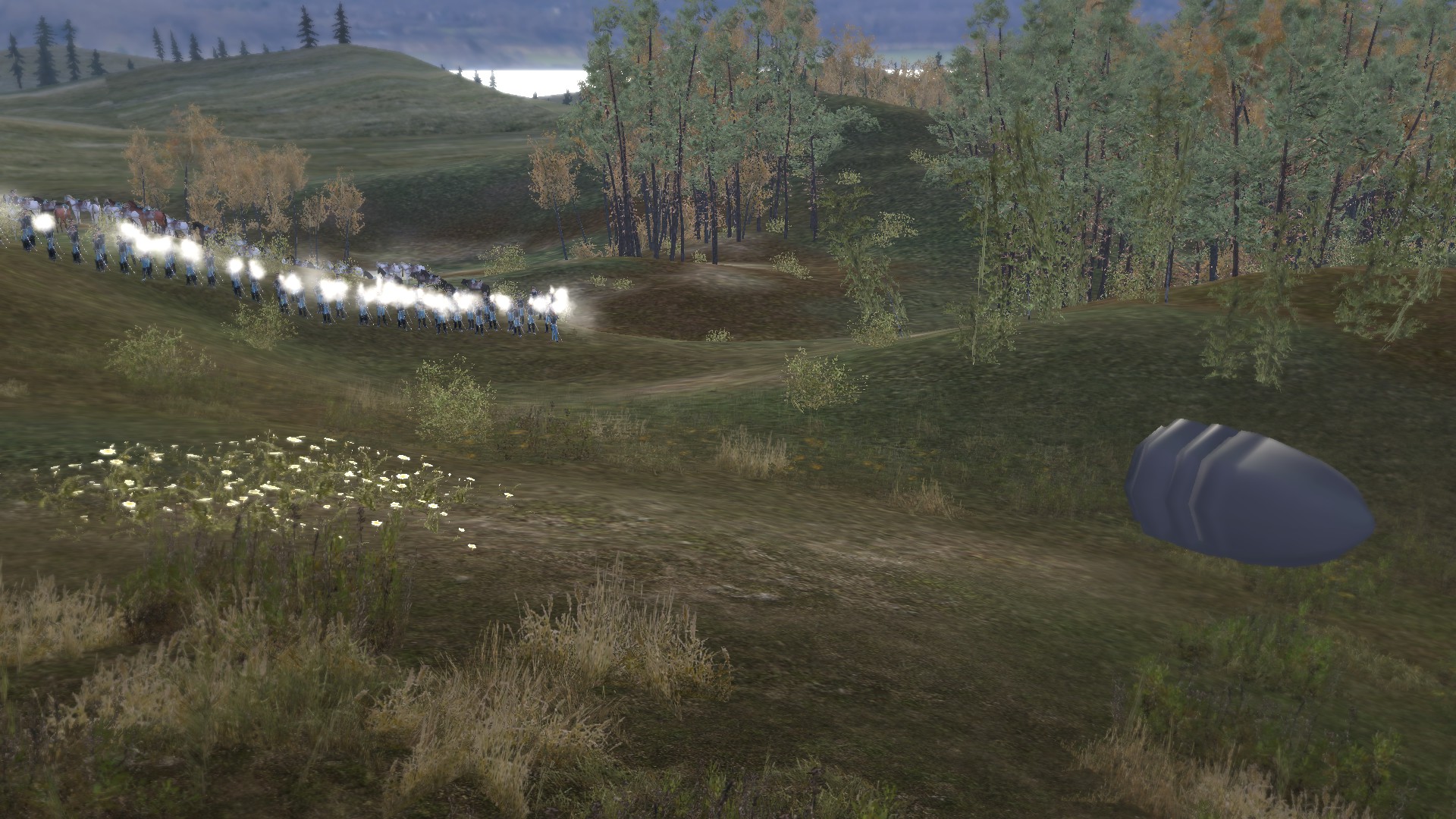
.44 Caliber Conical Ball
On the 19th century American frontier, large .44 caliber cartridges were considered the epitome of handgun ammunition for self protection, home defense, and hunting, enjoying a well earned reputation for effective terminal ballistics, accuracy, and reliability. Early revolvers were caplocks and loaded as a muzzle-loader. The user poured black powder into each chamber, rammed down a bullet on top of it, then placed percussion caps on the nipple at the rear of each chamber, where the hammer would fall on it. This was similar to loading a traditional single shot muzzle-loading pistol, except that the powder and shot could be loaded directly into the front of the cylinder rather than having to be loaded down the whole length of the barrel. Importantly, this allowed the barrel itself to be rifled, since the user wasn't required to force the tight fitting bullet down the barrel in order to load it.
In 1854, Eugene Lefaucheux introduced the Lefaucheux Model 1854, the first revolver to use self-contained metallic cartridges rather than loose powder, pistol ball, and percussion caps. It is a single-action, pinfire revolver holding six rounds. On November 17th, 1856, Daniel B. Wesson and Horace Smith signed an agreement for the exclusive use of the Rollin White Patent at a rate of 25 cents for every revolver. Smith & Wesson began production late in 1857 and enjoyed years of exclusive production of rear-loading cartridge revolvers in America, due to their association with Rollin White, who held the patent and vigorously defended it against any perceived infringement by other manufacturers, such as Samuel Colt had done with his original patent on the revolver. Although White held the patent, other manufacturers were able to sell firearms using the design, provided they were willing to pay royalties. In the United States, the traditional single-action revolver still reigned supreme until the late 19th century, when European powers quickly began to adopt double-action revolvers, and the U.S. soon followed.

New Cartridge Packs
The new bullets will also come with their own custom made cartridge packs, based on real life examples. Units armed with both smoothbore and rifle muskets will use both round balls and Minié bullets. Units armed with exclusively one weapon will use exclusively one type of cartridge. This means that regiments armed with smoothbore muskets, such as the Union's Irish Brigade and the Confederacy's Orr's Rifles will only use round ball ammunition, while regiments armed with rifle muskets will only use Minié balls. The cartridge packs will also grant damage bonuses based on the type of ammunition being used.
Full Changelog
- Fredericksburg map layout updated, based on actual schematics of the real life location.
- Placeholder buildings at Fredericksburg replaced, and models of real life structures added, including Marye's Mansion, the Innis House, the Stephens House, the Ebert House, the Stratton House, the Stratton Wheelwright and Blacksmith, and the Sisson's Store.
- Almost all buildings in Richmond and Washington replaced.
- White House added to Washington scene with custom interior.
- Davis House (Confederate White House) added to Richmond scene, with custom interior.
- New general store interior scene in Richmond.
- Baltimore scene replaced and the bugged interior has been fixed.
- Buildings replaced at the villages of Alexandria, Gordonsville, Lynchburg, Winston-Salem, Winchester, Harper's Ferry, Mechanicsville, and Manassas.
- Tipi's added to some Native American scenes. Work in progress.
- AI mesh added to Sharpsburg and Fredericksburg scenes. Soldiers will no longer get stuck behind fences or buildings, they will now be able to flawlessly navigate around them. Fences can also still be used as cover, units will stand behind fences and only go around when ordered to go in front of them.
- Corn field mesh updated to look more natural and less square, with corn stalks of varying heights.
- Trenches at Vicksburg slightly improved with new trench wall prop.
- Entry points and passages at Fort Donelson fixed, scene slightly edited.
- Palataka renamed to Gettysburg and moved north.
- Greeneville renamed to Shiloh and moved west. (No new scenes yet for Gettysburg and Shiloh).
- New Union Cavalry regiment: 3rd New Jersey Cavalry "The Butterfly Hussars"
- New authentic Civil War era projectiles are now fired from all firearms.
- Three new pretenders, with custom dialogue and appearance. Charles Jennison, Newton Knight, and Dull Knife. Following their quest lines will lead the player into moral dilemmas that are strongly rooted in the actual history of the time.
- Base party size increased. Players can gain charisma normally now, without needing to start off at 25, and the size of the player's party will be 114 at only 3 leadership skill.
- Generals now wear their uniforms inside of their headquarters, and will not wear hats.
- Fixed Springfield Model 1847 Artillery Musketoon and Pattern 1861 Enfield Musketoon so AI can switch to melee weapons when using those weapons.
- Fixed broken bayonet melee mode function for the Fayetteville Rifle Type III.
- Overhead attack with bayonets added.
- New animation for standing idle with bayonets while the melee function is turned on.
- Many soldiers will now use the butt of their rifles as clubs for their melee weapon instead of knives. Some units will still have knives and use rifle clubs, which turns out to be a good reflection of hand to hand combat in the Civil War; knives, bayonets, and rifle butts.
- New battle icon on the world map.
- Font color for Union names on the world map changed to a brighter blue to be easier to read.
- New sound effects for bullets impacting flesh.
- Four of the battle music tracks have been replaced.
- Replaced the coronation music track left over from native M&B.
- Replaced the picture for ordering your soldiers to attack without you in field battles.
- New variant for Confederate grey kepi with infantry and cavalry cap badges, and also one with a lighter grey color.
- 42nd Pennsylvania, mesh for bucktail in kepi made smaller and more proportional.
- Springfield Model 1835 Flintlock replaced with the 1835 percussion conversion for Union Volunteer Infantry.
- Regimental color guard added to the 8th Missouri Infantry. Carries a generic regimental flag.
- Jim Baker given increased stats appropriate to his backstory of being a frontiersman.
- Rifles and carbines now have a bonus vs. shields and can knock characters down.
- The old black cartridge box mesh that appeared as previews for bullets in the inventory screen have been replaced with authentic civil war cartridge packs.
- Previews for weapons in the inventory screen fixed.
- Female nurse dress added to inventory of battlefield nurses, surgeons and doctors. Stats also modified to be appropriate to medical units. Now if you have a few of them in your party, they will help with surgery, wound treatment and first aid.
- Cavalry sword added to Hampton's Legion Mounted Infantry.
- Added some of the armed civilian outfits to the Confederate Home Guard, to help visually show how they are more of a low quality, armed citizenry unit rather than professional soldiers.
- Messed up dialogue with bandits and village walkers has been fixed.
- Nordic swords dropped by belligerent drunks replaced with knives.
- 11th Mississippi and 19th Illinois hat hair darkened.
- Scabbard added to Model 1840 Cavalry Saber.
- Prices increased for cotton, tobacco, corn, rice, whiskey, and wine to make them more profitable to sell.
Known Issues/FAQ
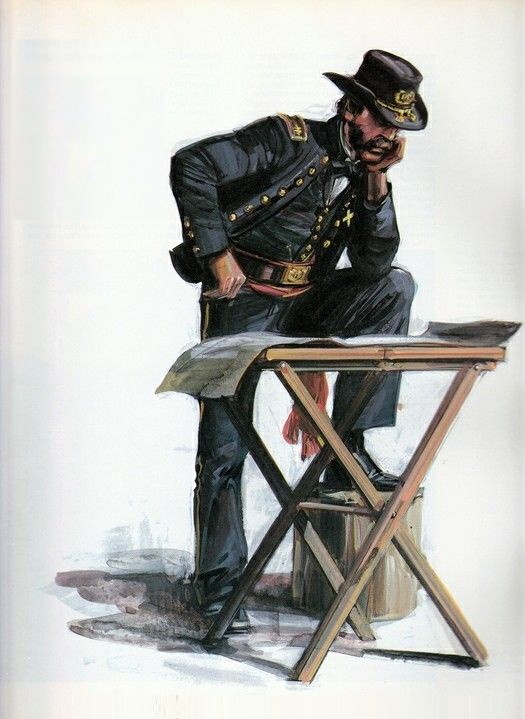
- Tournaments are not finished and can't really be worked on without the module system. We aren't going to work with the module system for a while, so anything that requires it is out of the question for now.
- Mule trains still cause crashes for some unexplained reason.
- Gunfire sound effects can sometimes cut out when many rifles are firing simultaneously.
- Revolvers will not show up in markets and fixing this requires module system.
- Armies still recruit too many flag bearers sometimes, and this can only be fixed with the module system.
- AI mesh is not done for every location on the world map, which means AI will still get stuck on things in some places where this is not yet completed. This will continue to be worked on and updated as time goes forward.
- Q:Freelancer? A: Freelancer requires the module system.
- Q: Artillery? A: Working artillery requires the module system.
- Q: New factions? A: No new factions are planned.
- Q: New weapons? A: We do not have plans to add new weapons. The weapons we currently have were donated and we do not have the skills to make new ones from scratch.
Call For Volunteers!
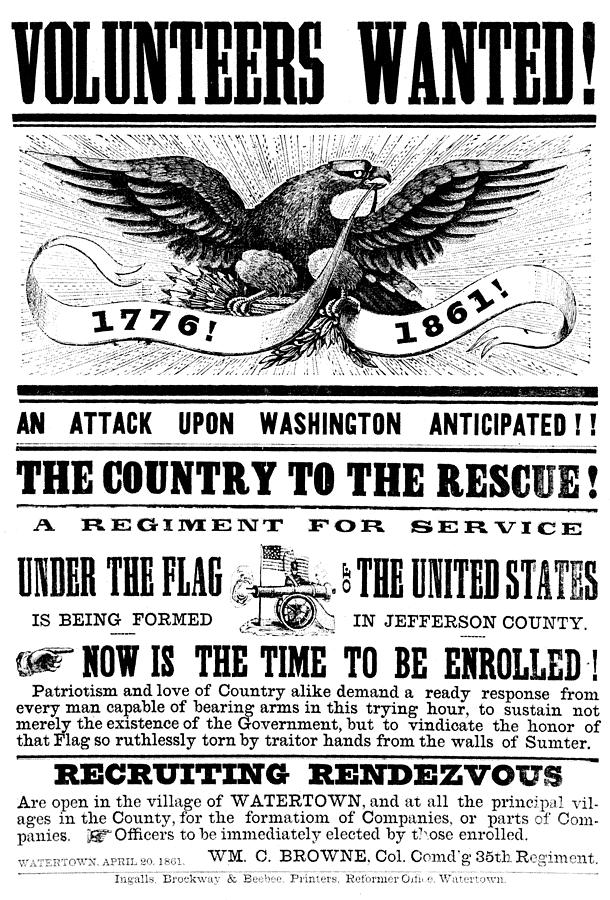
Our team is looking for a few good and willing souls to assist us in this grand project we are undertaking. We need someone skilled with video recording and editing to make trailers and gameplay videos to help show the mod at it's full potential. Me and Matsuri5 don't really have good recording or editing software and are not very skilled in making high quality videos. We're also only two people and having someone dedicated to the media side of the mod would be a huge help for us.
We are also looking for someone who can help us make some new animations and would be able to help us get them into the mod if need be. We don't need to replace all the animations though, we are only looking for a few specific ones, so if you are confident in your abilities as an animator, please do not hesitate to get in contact with us.
That's all for now!
Thank you for taking the time to follow this project and give your support, we are humbled and grateful to you all. We hope you enjoyed this latest news article and have fun playing with all the new stuff. We look forward to continuing to improve this mod, and one day expand to using the module system to be able to add in some of the more advanced and lucrative features that we are all wishing for.
Have a wonderful holiday season, and may your homes be filled with blessings and love.
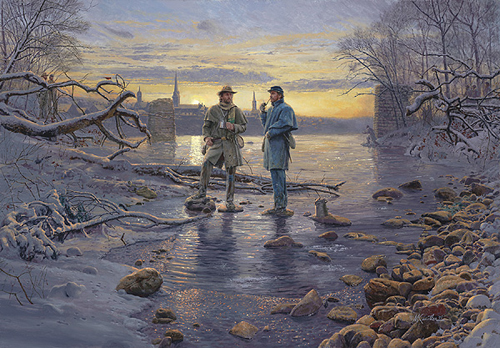

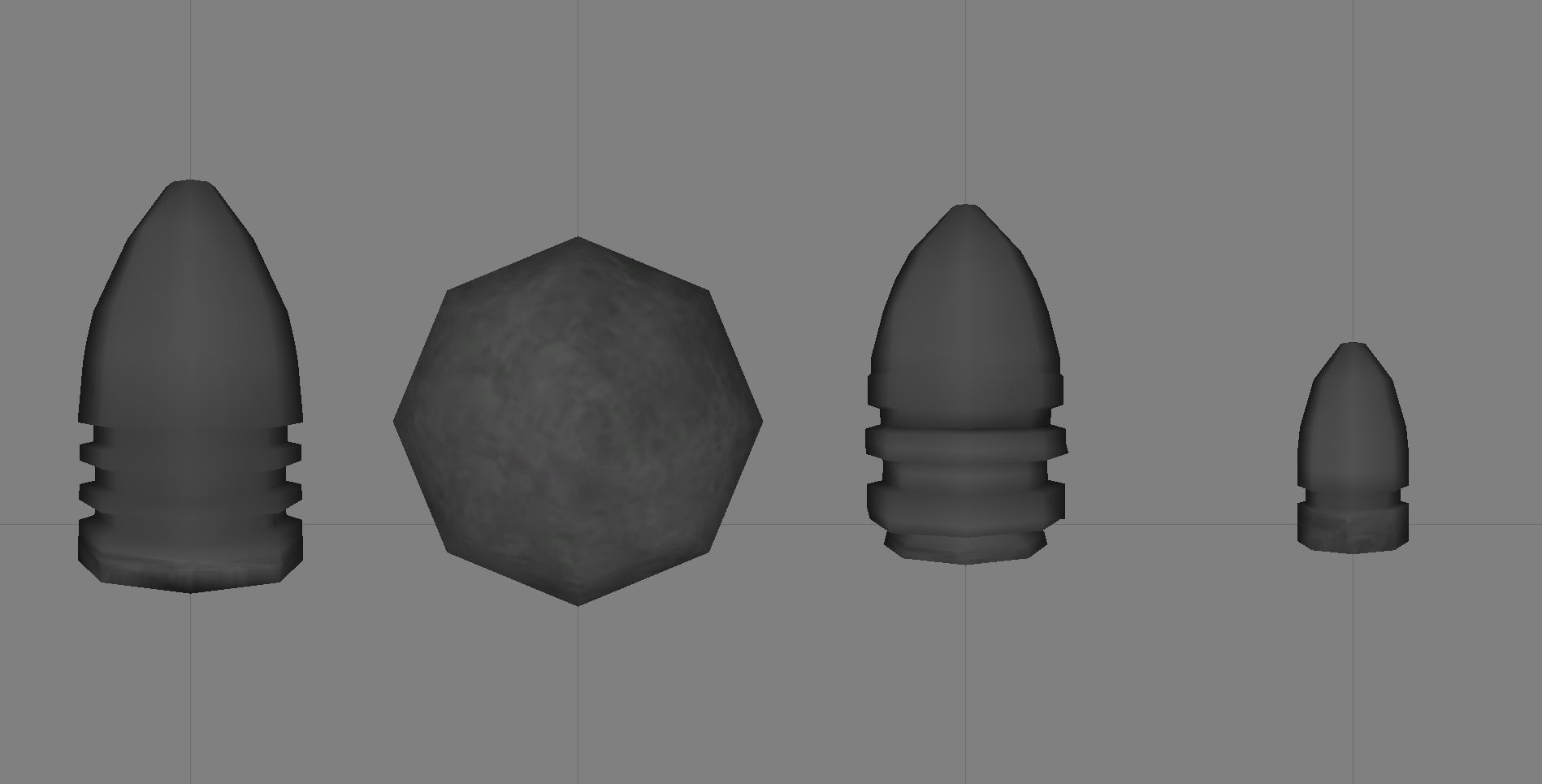
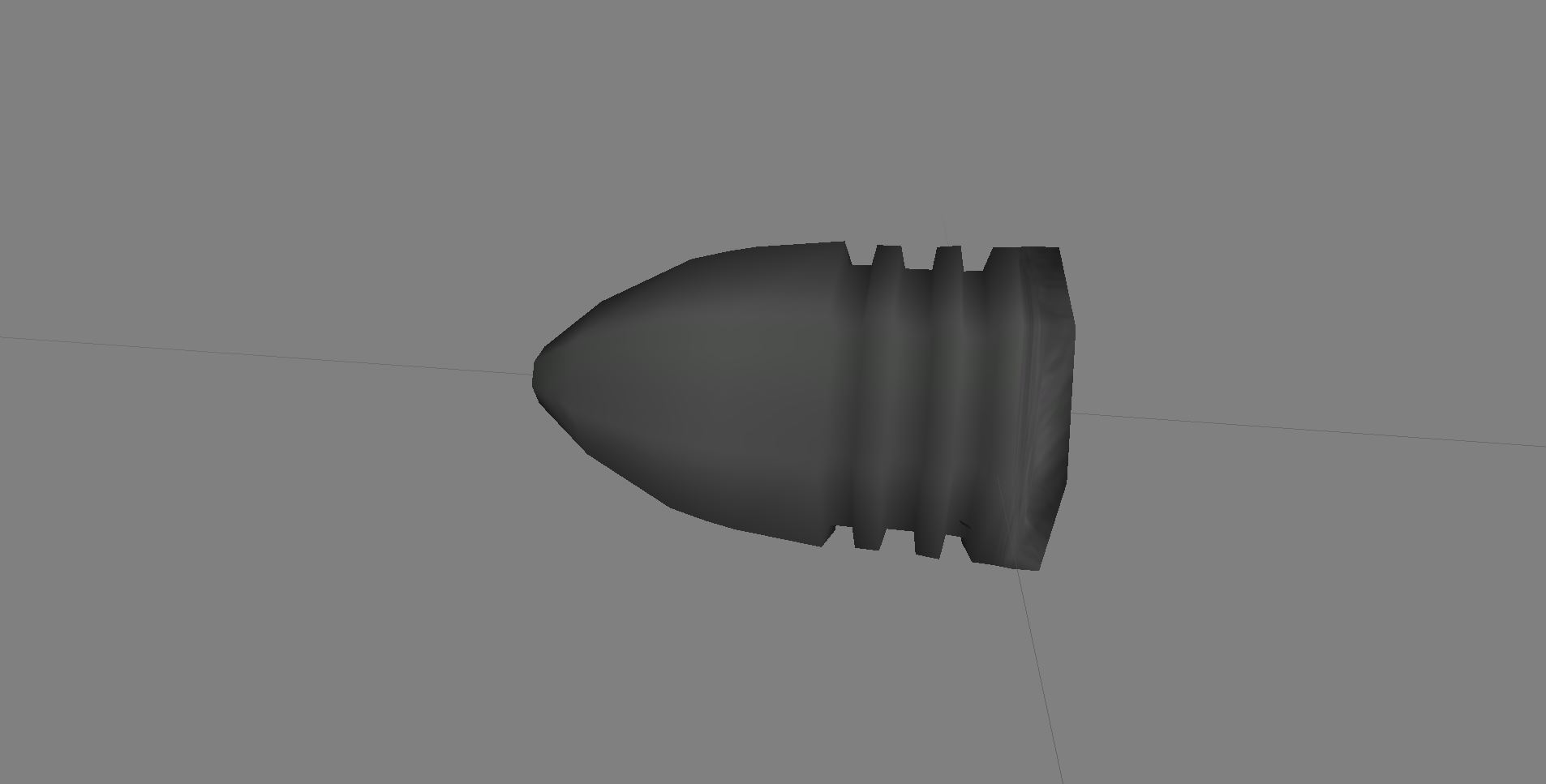
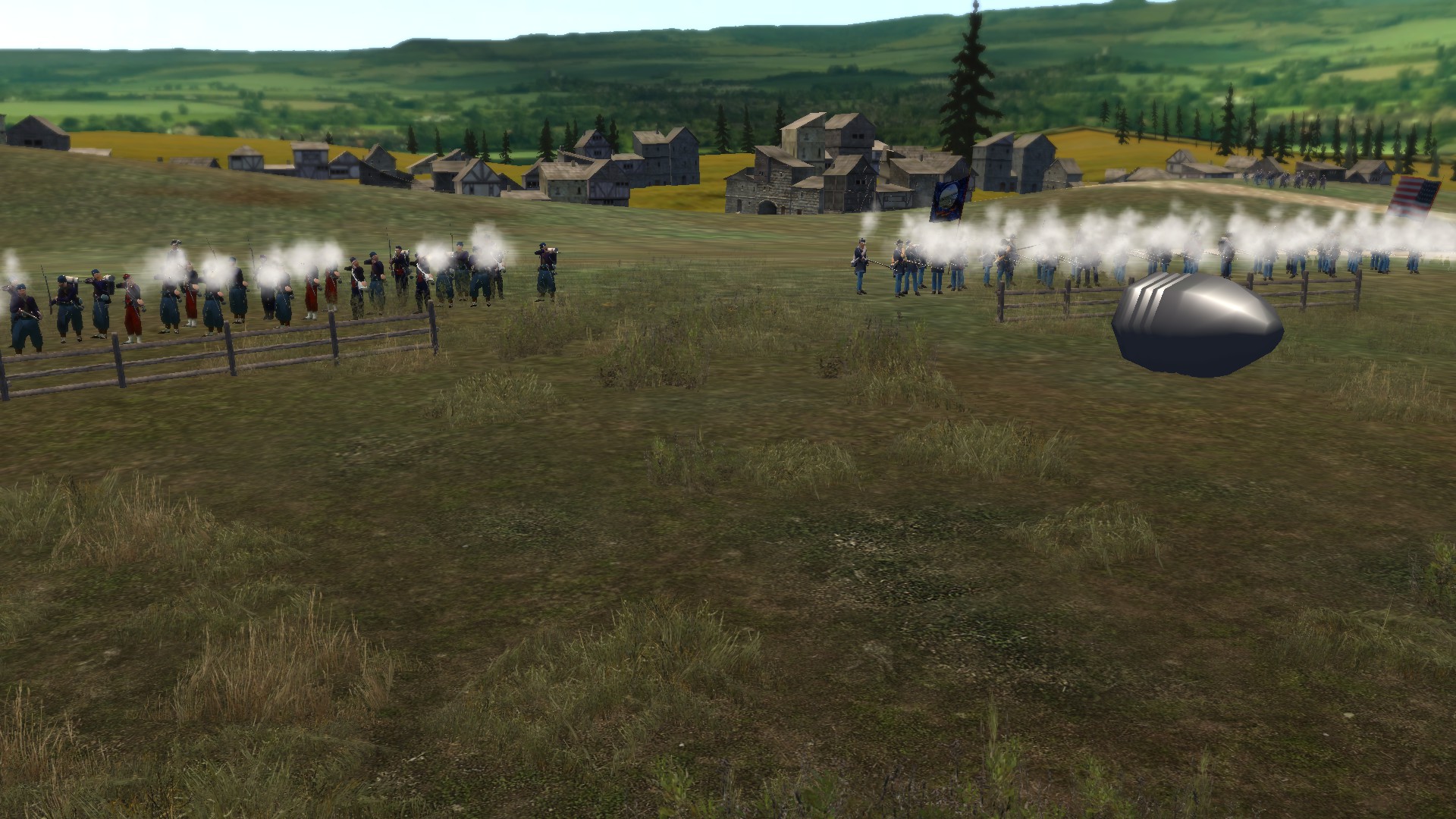

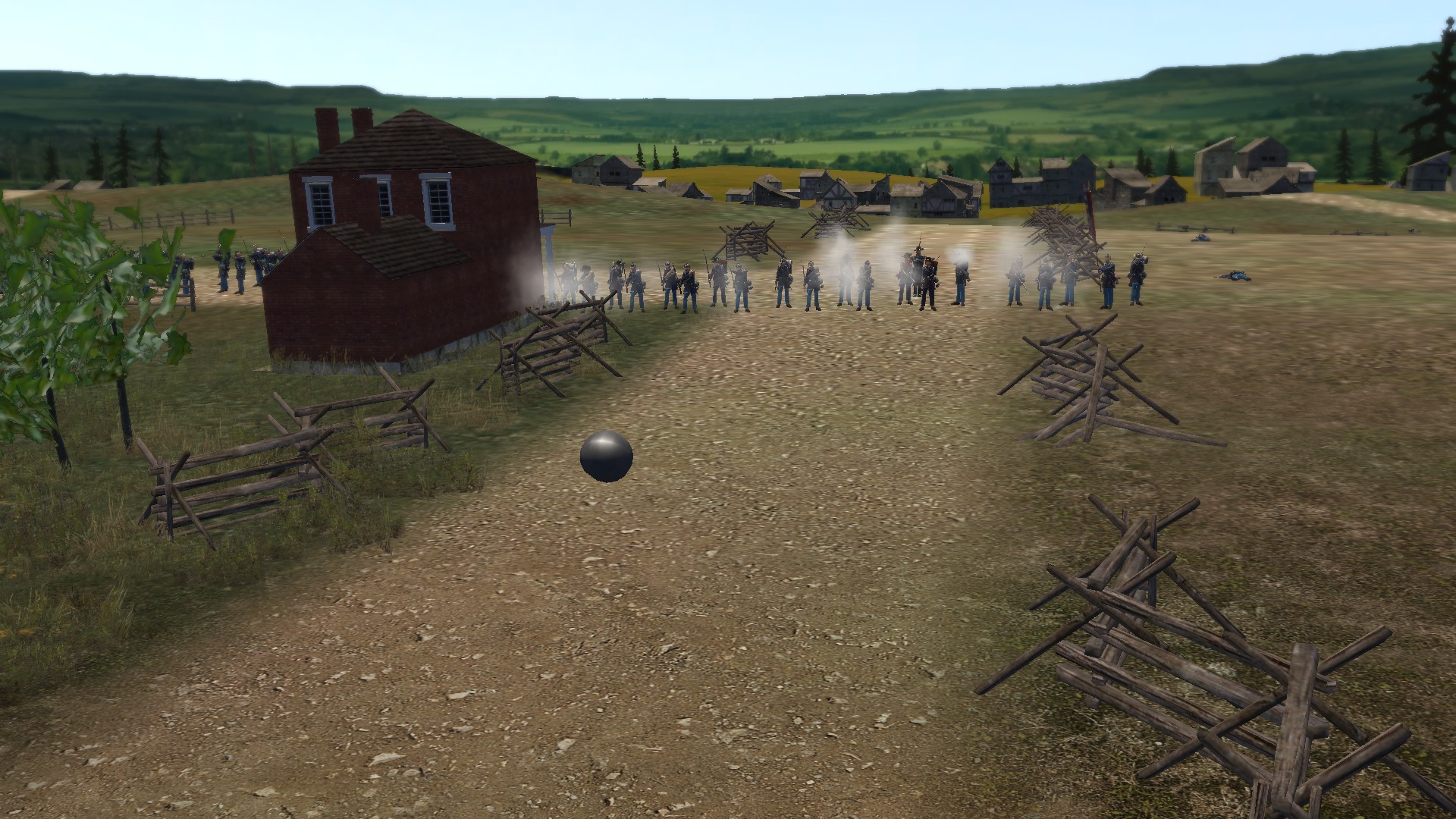
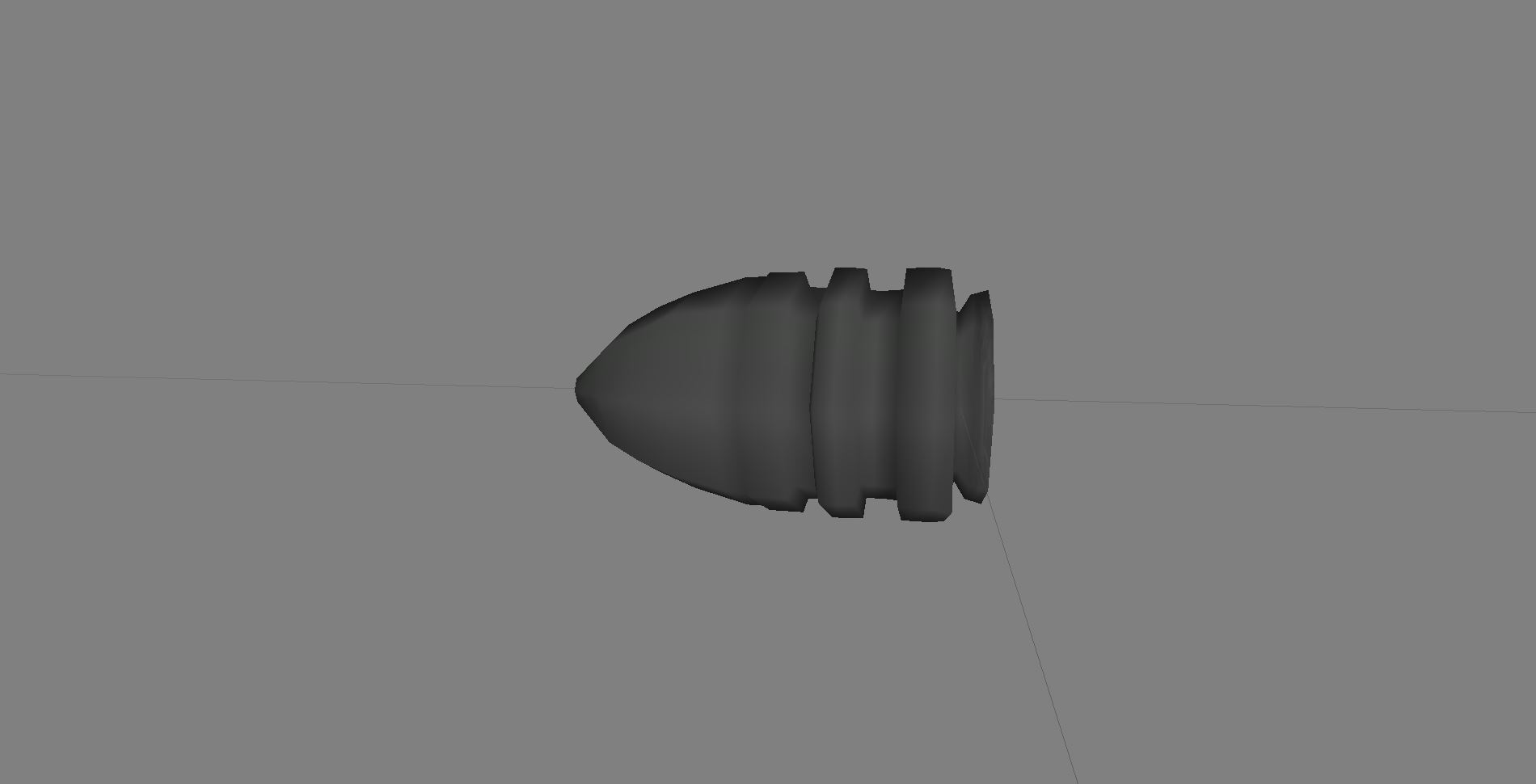
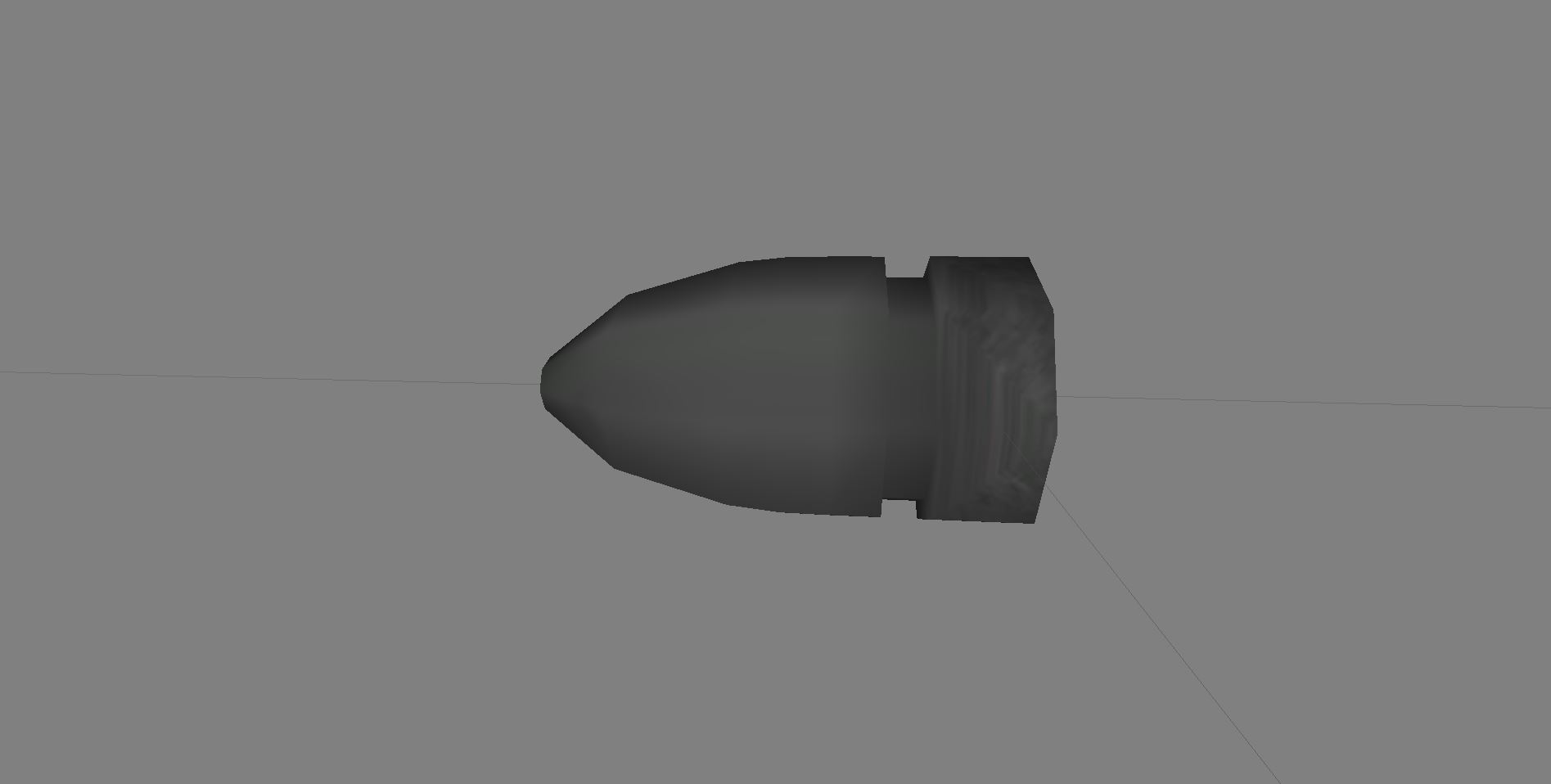
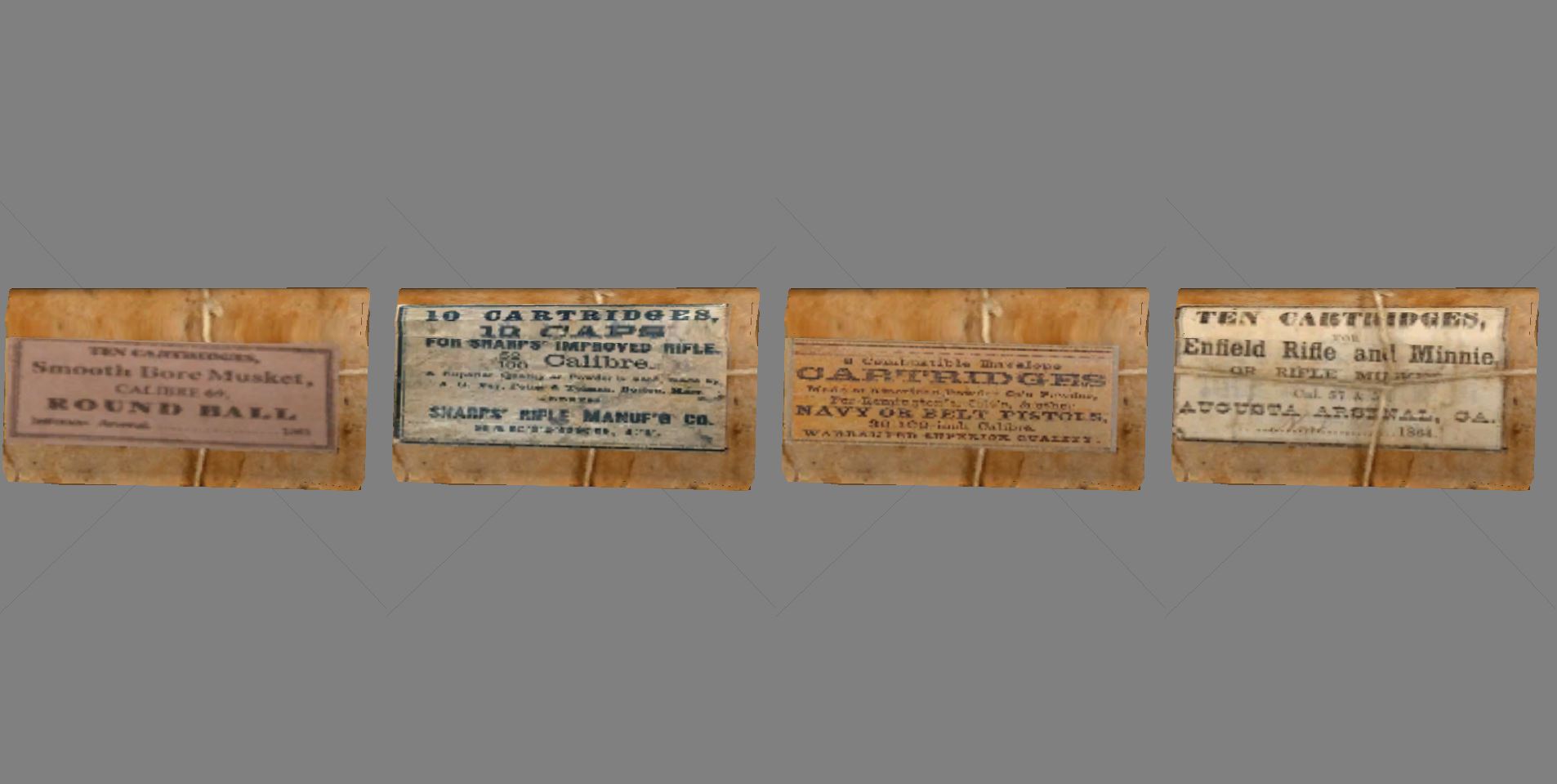


This is so ******* sweet great job guys
Thank you so much, we really appreciate it! :)
The dedication to historical detail is as insane as always. You should seriously start a Civil war related blog or something, these pieces of information are lovely to read
Thank you, I'm really glad you enjoy reading them! I guess you can consider these articles to be my Civil War blog ;)
Hello! The mod is great, but for some reason, the game closes at the start of any battle, with no erro message. Only happens at this mod.
Hi there, sorry to hear you're having some trouble. Were you fighting against a mule train or against an army? Also, does it crash in every battle, or is it random?